
Until the mid 1970s, a house and a home, Longlands Hall, stood where now there is only Industrial and Commercial Business Units comprising the Longlands Industrial, or Trading, Estate on the Wakefield and Dewsbury Road at Flushdyke Ossett. In its prime the 18th Century Longlands Hall was the 12 roomed home of the largest land owners and the richest family in Ossett. The Hall stood in grounds extending to 16 acres, with a further 5 acres nearby and with frontage on to the Wakefield to Halifax Turnpike Road at Flushdyke. Its location, with convenient east to west and north to south routes, was perfect for its owners’ business as wool staplers and land owners. What follows is Alan Howe’s summary of the history of The Haighs of Longlands Hall; his full research of Longlands Hall is available in the DOWNLOADS section of this Ossett Heritage website.
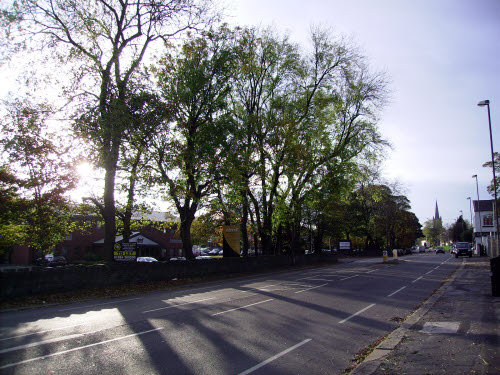
Above: Longlands House site (October 2014) on the Wakefield & Dewsbury Road. Ossett Holy Trinity Church spire in background.
From left to right: In the near distance was Little Longlands (meadow land) which is now DFE (Wakefield) Ltd. In the middle distance, just after the bollards, Smith Way leads off to the left. Longlands Hall plantation, gardens and tennis were bisected by Smith Row. In the far distance, just beyond the white sign for Concorde Group, was Longlands Hall proper. The Hall and its extensive range of outbuildings stood on the site of Concorde Group offices. Note the mature trees which, even today, mark the extensive road frontage of what was once Longlands Hall and its grounds.
The Haigh family ownership of the fields named Longlands dates to the mid 17th century but the references are only to land used for pasture and meadow. The ownership passed down generations of the Haigh family and in 1746 part of the land named Longlands was inherited by the “earliest” Joshua Haigh (1670-1746), a woolstapler, who purchased another eleven acres. Three more generations, a son (1714-1784), a grandson (1741-1814) and a great grandson (1767-1836), followed the earliest Joshua and each inherited the Longlands estate. Each was an only son and each was named Joshua.
When the son, Joshua Haigh II (1714-1784) of Ossett died in 1784 his son, Joshua Haigh III (1741-1814), became the first Haigh to describe himself as Joshua Haigh of Longlands. In 1771 Joshua Haigh III took action against a neighbour at the Yorkshire Summer Assizes and presented a plan of the lands in question. That plan included a crude but telling illustration of Longlands Hall providing positive proof that the House existed by 1771.
In 1763, Joshua Haigh III married Anne Robinson at Dewsbury All Saints Church. Their first two children were baptised in Wakefield in 1764 and August 1766 but their third child, Joshua III, was baptised in Dewsbury parish in June 1767. This suggests Joshua III and Anne moved from Wakefield parish to Dewsbury parish between mid 1766 and late June 1767 and it is likely that the house, Longlands Hall, was built by Joshua III at this time.
Joshua Haigh IV (1767-1836) died at Longlands Hall in 1836, aged 69, and a bachelor. His five spinster sisters, the Misses Haighs who lived with him at Longlands Hall, all died between 1843 and 1857. By 1843 the Haigh family had built an Ossett land holding of 306 acres which represented almost 10% of the township’s total acreage.
The end of the Haigh of Longlands Hall dynasty was certain since the six surviving Haighs in this generation all died unmarried and without children. There were however plenty of cousins, albeit not bearing the Haigh surname, and the Haigh’s favourite, was Charles Wheatley, J.P., land and colliery owner. Charles, of Sands House Hopton, Mirfield, was a man of enormous influence and wealth in his own right. In 1851 he owned 150 acres of land and employed over 200 men and boys. In 1872 his West Riding land ownership, including the Haigh’s former land, extended to 356 acres. Other members of his family owned another 550 acres in the Riding.
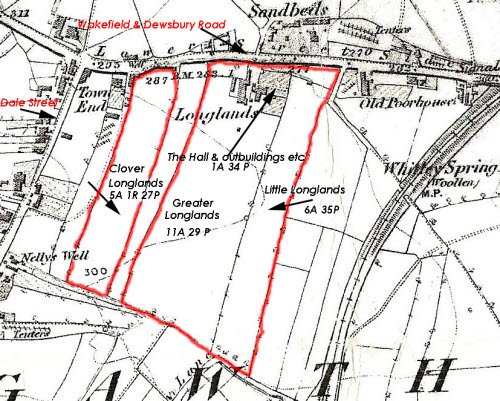
Above: 1850 Map showing Longlands Hall Estate and acreage.
Between 1861 and 1901 Longlands Hall remained in Charles Wheatley’s ownership but he preferred his Sands House and rented Longlands Hall during this forty years to two Ossett families. William Speight, a Woollen Manufacturer was the tenant by 1861 and latterly Abraham Pollard, a Mungo Manufacturer. The Pollard family lived at Longlands Hall until 1921.
The owner of Longlands, Charles Wheatley, a bachelor, died in late 1900, aged 87. His estate, including Longlands, was valued at £554,000 (£60 million in current values) and after legacies the remainder was left to his cousin once removed, Eleanor Steele (nee Robinson), and, on her death, her children. Eleanor was the daughter of a Horbury Apothecary, G.P. and Surgeon and in 1873 she married Adam Rivers Steele, an attorney at law who was also wealthy in his own right.
In 1910 the Hall was described as ;- House, Greenhouse, outbuildings & Land Cellar K(itchen) Pantry, Hall, Servant’s Hall, Dining, Breakfast & Library, 5 bedrooms, Boxroom, Front & Back Garden, Lawn etc. Coachman’s House Room 2 beds. Stable, 3 stalls, loft over & Coachhouse. Farm buildings, Barn, Stable, Mistal for 3 cows. Oldish property well built in good repair, stone built House , Stable & part farm buildings of brick.
Eleanor Steele died in 1910 at her 35 room Loddington Hall home in Leicestershire and her only son and her daughters, the Misses Steele, inherited the estate left to them by Charles Wheatley. In 1929, Longlands Hall and the Little Longlands land was sold to Colin Rowland Crook , Brickworks owner of Wakefield. Local man, Tommy Brooke was tenanting part of the Hall and some buildings from Mr Crook.
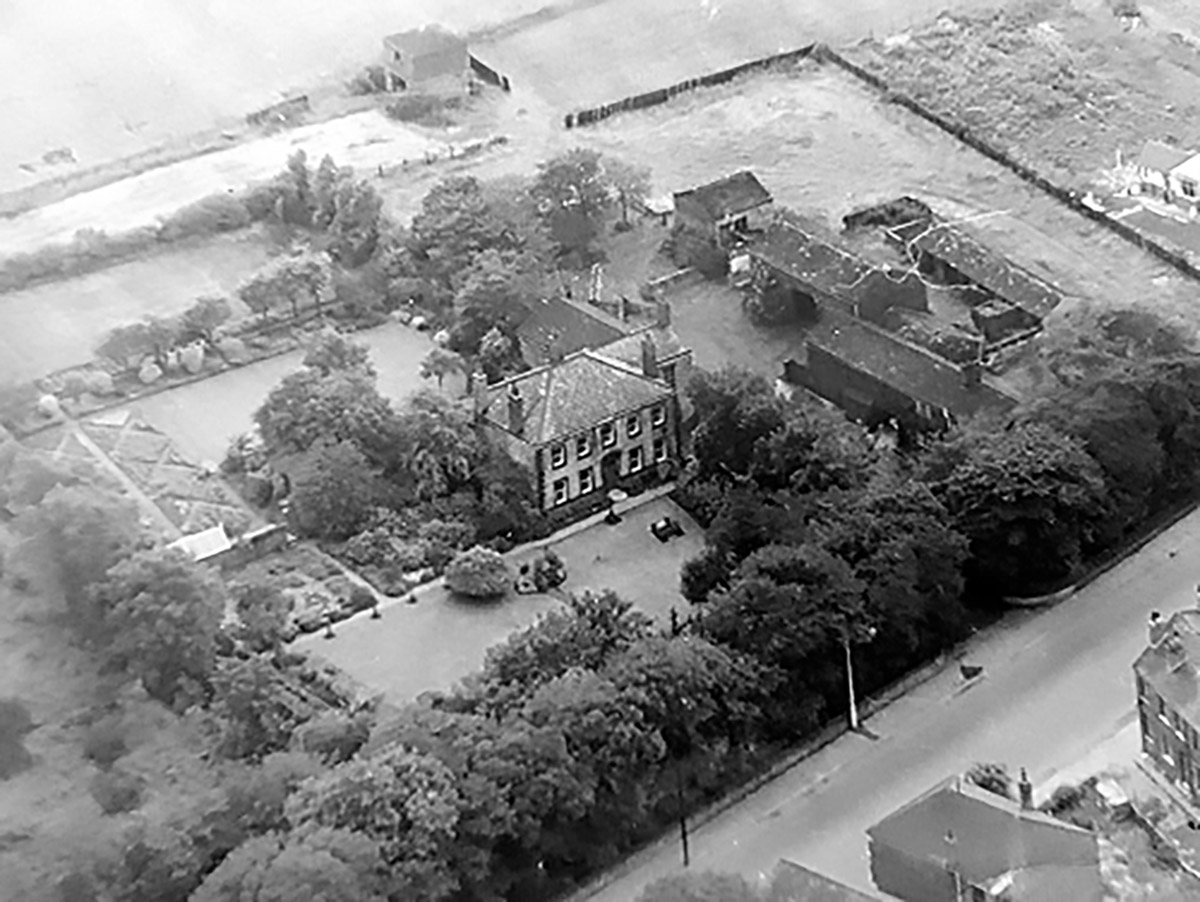
Longlands Hall and environs pre 1973. Photograph courtesy of Jennifer Duckett
Colin Rowland Crook, the owner of Longlands House and the Little Longlands land, died in 1971 almost 200 years after Longlands Hall was built. It is probable that, shortly after his death, Mr Crook’s executors sold his ownership to Ossett based Milner Developments Ltd for the construction of industrial units on what became the Longlands Industrial Estate. By 1973 Longlands Hall had gone and industrial and commercial development had begun on site.
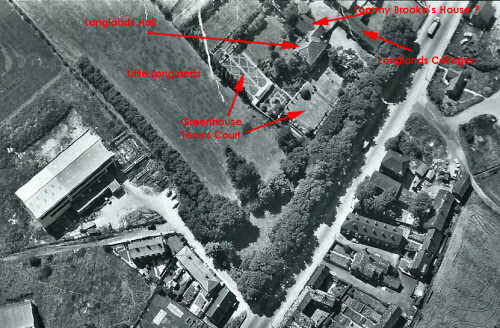
Above: Aerial Map of Longlands in August 1967 shortly before its demolition.
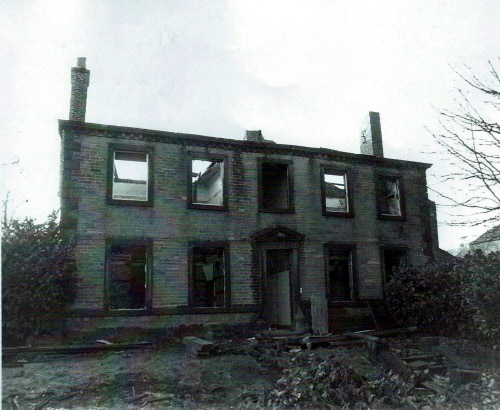
Longlands House in the early/mid 1970’s during demolition. Photo courtesy Ruth Nettleton.
Forty years later no trace of Longlands Hall remains but for almost 100 years it was the home of the Haigh family who in 1843 owned more than 5% of Ossett’s total acreage. In its time, and perhaps over all time, Longlands Hall was also the largest and most imposing dwelling in Ossett.
For much of its history Longlands Hall’s closest neighbour was the Ossett Poorhouse as will be seen from the 1850 map reproduced elsewhere. The proximity of Longlands Hall and Ossett Workhouse, stands as a reminder of the contrast in the lives of 18th and 19th Centuries Ossett people – the haves and the have nots. Families who lived so close to one another but who probably knew nothing of their closest neighbours’ lives. The Ossett Poorhouse and Longlands Hall and were so close but they were worlds apart.
Summary
Joshua Haigh came to Ossett between 1700 and 1703 at the invitation of his kinsman Joseph Haigh who had inherited land and property in Ossett from his father, John Haigh of Whitley. The land included acreage at Longlands that John had acquired in 1688-89 and his “kinsman” Joshua Haigh, was renting this land by 1709.
Between 1712 and 1725 Joshua Haigh assembled more land in Ossett including 11 acres at Longlands but by the time of his death in 1746 there was no evidence of a dwelling on Longlands land. His son and his grandson, also called Joshua Haigh, worked as wool staplers and became major landowners in Ossett. In 1771 the first documented evidence emerged of the existence of Longlands Hall and by 1784 Joshua referred to himself as Joshua Haigh of Longlands.
Thus the evidence suggests that Longlands Hall was built between 1746 and 1771. In between these dates, in 1763, the third Joshua Haigh married and had two children baptised at Wakefield in 1764-1766 and then a child baptised at Dewsbury parish (which included Ossett) in 1767. It is likely that the mid August 1766 to late June 1767 period was the period during which Longlands Hall within a 16 acres Estate, was built as a home for Joshua’s family.
On the death of last of the Longlands Misses Haighs in 1857 the Haigh real estate, including Longlands Hall passed first to the Haighs’ cousin , the wealthy Charles Wheatley of Sands House, Hopton and then, on his death in 1900, to his cousin, Eleanor Steele (nee Robinson). Her children, one son and three daughters inherited the Haigh and Wheatley real estate on Eleanor’s death in 1910.
Between 1861 and 1921 Longlands Hall and its estate land of about 16 acres was tenanted by only two Ossett manufacturing families, the Speights and the Pollards. In 1929 the House and 9 acres were sold to Colin Rowland Crook. He lived at the House until his death in 1971. Shortly after Mr Crook’s death the remainder of the estate and the House itself was acquired by Ossett based Milner Developments Ltd who demolished the House and created industrial units in its stead. By 1973 development had begun on site.
For almost 200 years Longlands Hall was home to just four families with three of them involved in Ossett’s staple industry, wool manufacturing, for 150 of those years. Over the early years of its life the House and grounds would echo to the laughter of the final generation of the Longlands Haigh children. Much later this may have turned to a mood of melancholy as the unmarried Haighs grew old together and died, one by one over 21 years, in the home in which they had lived all of their lives.
For most of its time the House was in the right place and at the right time but time and “progress” caught up with it as it fell in the way of the next industrial revolution and the need for jobs. Like the rest of the Flushdyke community it was swept away, as if it never existed, by the industrialisation of the area in the 1960s and 1970s.
Alan Howe from research in December 2014
Owlers Farm is situated in the Flushdyke district of Ossett to the north of the Wakefield to Dewsbury Road. Today the district is dominated by industrial and commercial businesses but less than 100 years ago it was a thriving residential area.
Above: Owlers Farm
Introduction
Before the industrialisation of the district in the 1960’s the area was dominated by the main Wakefield to Dewsbury thoroughfare which ran through it. This road had long been a major highway variously known as Streetside, Ossett Street and the Wakefield to Halifax Turnpike Road. The origins of the area are much older and it is likely that Streetside took its name from a Roman road though others believe it more likely that the Roman route ran to the north along a natural ridge which can still be seen. Either way there is little dissent concerning the existence of a route here or hereabouts.
That there was early occupation here is not doubted and the importance of the area was reinforced by the Lord of the Manor of Wakefield when he established a 1300 acre hunting park in the locality. This was known as the New Park, there being a smaller Old Park to the south of Wakefield town. The New Park is situated to the north of present day Flushdyke and the Wakefield to Halifax Turnpike Road once formed the southern boundary of the Park. In its early form the boundary was reinforced with palings to prevent the deer escaping from the Lord’s Hunting Park and it is from this that local names such as Paleside originate.
The land which currently comprises Owlers Farm was part of the New Park. A plan of the Park estate dating from 1711 records field names, size and tenancy and shows that the land which is now Owlers Farm was then part of a larger farmstead totalling 190 acres.This research by Alan Howe seeks to discover the ownership and occupancy of Owlers Farm over the years. The history of the Farm is inextricably linked to the history of the New Park of which it was a part. Whilst there is no single history of the Park, mention of it is made in many books and histories of Wakefield and in the Wakefield Court Rolls as early as 1253. This research reproduces some references and descriptions of the New Park as it was some 700 to 800 years ago.
Whilst it cannot be known whether the existing Owlers farmstead stood here earlier than the 18th Century it is certain that the land that was worked here was part of the Hunting Park established and owned by the Lord of the Manor of Wakefield. The Manor of Wakefield was granted first to the 1st Earl de Warrene in 1088 by William 1st, also known as William The Conqueror, following his victory over King Harold at the Battle of Hastings, some 22 years earlier in 1066. Consequently this research also includes some history of the Lords of the Manor of Wakefield
 Owlers Farm and Flushdyke in 1850
Owlers Farm and Flushdyke in 1850
The Farm in context
Owlers Farm, once known as Ellers, was a part of the Wakefield New Park; one of the Hunting Parks established by, and for the pleasure of, The Lord of The Manor of Wakefield. The history of the New Park and of the Manor is therefore the history of Owlers Farm, the land which was a part of the farmstead and the families who owned it. But until the 20th Century the owners were the nobility, most of whom would never have set foot on the Farm and would certainly never have worked it. This history traces the story of the owners and occupiers of Owlers Farm and this section provides a potted history of those findings.
But first how was it that Owlers Farm came by its name and were any other activities carried out here? Local historian, Richard Glover, believes Owlers is derived from the name “Ellers” and indeed the field in which the farmstead now stands was known in 1711 as Ellers. This in turn derives from “Alder tree croft, coppice and stream” Nearby is Brick Close and Sandale Close (Sandbeds) suggesting the possibility of raw materials for early brick making processes. Such manufactories would require heat and this would be provided by cutting and burning wood (including alder) from nearby Haggs (felling of trees,copse) to provide charcoal and heat in kilns for the

Above: 1711 map of the west section of the Earl of Cardigan’s New Park.
Ellers Farm bottom left adjacent to the Halifax to Wakefield Turnpike Road at Flushdyke
In 1066 William of Normandy invaded England, killed King Harold at Hastings and assumed the Crown. In 1088 he rewarded one of his supporters, Earl De Warrene, with the grant of the Manor of Wakefield. The De Warrenes were to hold the Manor and all its lands until 1362 when the Manor reverted to the Crown. In 1629 Charles I granted the Manor to Henry Rich to whom he owed money but around this time the ownership of the New Park was separated from the ownership of the Manor and the Savile family became owners of the New Park.
In 1668 Frances Savile married Francis, Lord Brudenell and in 1671 they inherited the 1300 acre New Park including the 200 acre Ellers holding. The Brudenells, who were also the Earls of Cardigan, held most of the New Park lands until 1889 when some were sold. Owlers Farm had no successful bidders and it was retained by the Brudenell family until 1923 when, for the first time, it was sold to commoners, Ernest Albert Brown and his wife Rosey. When Ernest died, ownership was inherited by his nephew, Harry Leach in 1954 and by 1958 he had sold the 90 acre farm to Norman Stead. In 2021 the Farm remains in the ownership of the same family.
Those earlier times will have been hard and yet the families who were here stayed for long periods. By1711 Mark Whitaker was recorded as the tenant of the 190 acre Ellers farm and the family were also recorded as tenants between 1771 and 1822. Ann Whitaker married Ellers tenant Mark Stephenson in 1820 and died in 1867, the year after her husband Mark, thus bringing to an end at least 150, and maybe 200, years of the Whitaker family’s occupancy of Owlers.
He was followed as tenant farmer by Francis Edwin Pape, the son of a farmer from Stanley with Wrenthorpe. Francis remained a bachelor living with his widowed sister and working Owlers for about 40 years until about 1909.
Around 1909 Francis Pape retired to Stanley and was succeeded as tenant of Owlers Farm by Ossett born Manufacturer and Farmer, James Herbert Brook. He was followed by Ernest Albert Brown and his wife Rosey in 1923, by which time the farm comprised 91 acres 2 roods and 9 perches. Ernest was born at Howley Hall Farm Morley owned by Lord Brudenell, Earl of Cardigan who also owned Owlers Farm. Howley Hall itself was built in 1590 by the Saviles (the subsequent owners of the New Park) and played an important part in the Civil War in the 1640’s when it was first captured by the Parliamentary forces then re-occupied by the Royalists.
By 1935 the Farm holding was rented to George Nettleton, the son of a Publican from Bottom Boat Stanley. Ernest and Rosey Brown died childless and their estate was inherited in 1954 by their nephew, Harry Leach, a butcher of Bank Street Ossett. George Nettleton continued as tenant until he retired in 1958 aged 65.
In the same year Harry Leach sold the 89.995 acre Owlers Farm to Norman Stead, previously the farmer of Brooklands Farm, Holywell Green, Halifax. In 2021 Owlers Farm is worked by Norman’s son, Raymond, and grandson, Philip Stead, and their respective families.
A fuller history of the Farm, the New Park and the Manor of Wakefield is available in the DOWNLOADS section of this Ossett Heritage website.
Alan Howe from research in November 2010.
MANOR HOUSE, MANOR LANE by Alan Howe
With emphasis on the life of first owner Mark Wilby.
Manor House or Manor Villa is situated on Cave Well Gardens, off Manor Lane, Ossett. The grand house and its grounds were built in 1870-1871 by Ossett mill owner, Mark Wilby (1827-1912), one of the partners of nearby Manor Mill, which has now been demolished and replaced by housing. Manor House was built on land which Mark Wilby had purchased from Nathan Mitchell who had built nearby Bleak House on Manor Road in the 1860s.
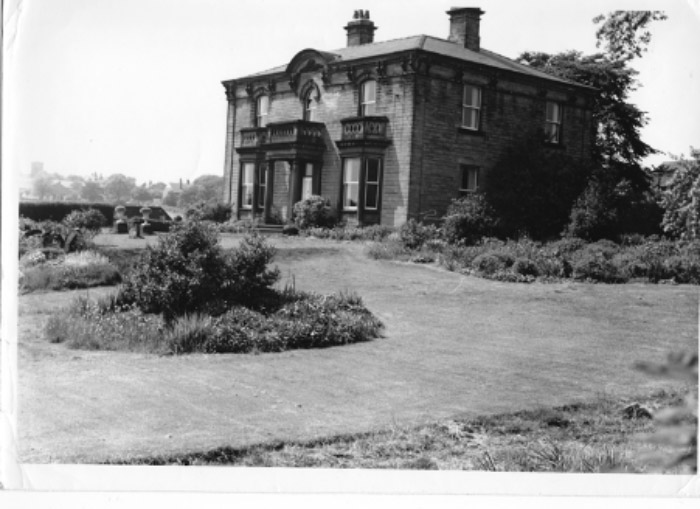
Manor Villa (House) in grander times. Courtesy of the Brook family of Ossett.
In November 1869 Mark Wilby, cloth manufacturer purchased 2 acres, 1 rood and 27 perches of land on which he built Manor Villa in 1870 – 1871. Mark was born and baptised in Ossett on 10th June 1827, the son of George Wilby (1790‐1879) an Ossett woollen cloth manufacturer and his wife Jane (nee Atkinson). Mark was the fifth child of eleven born to the Wilbys between 1818 and 1841; in the latter year the family lived on Middle Common, Ossett. By 1851, Mark (24) was a woollen cloth manufacturer in his own right. The same year he married Martha Clegg (born 1829) and by 1871, Mark and his wife Martha were living at Manor Villa with six children born between 1853 and 1866.
It is important to emphasise that the dwelling was not a Manor House in the usual sense but rather a house which was built on or adjacent to Manor Road which drew its name because it was the road to the 17th Century Sowood Manor House which once stood on land off Storrs Hill which is now occupied by Ossett Academy.
Alan Howe’s history of Mark Wilby’s Manor Villa was researched and written in 2010. This is a summary of that research of the house and Mark Wilby’s life. The full history is available in the DOWNLOADS section of this Ossett Heritage website.
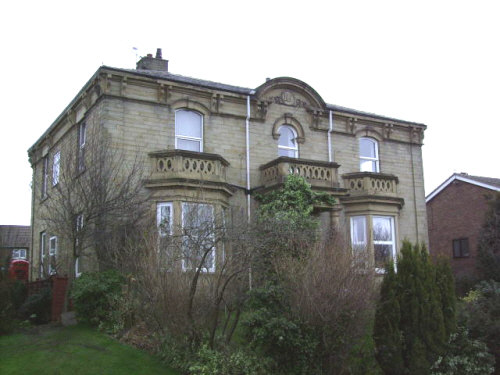
Mark Wilby’s Manor House now domestic apartments. Photo Alan Howe

Mark Wilby’s initials carved high in the stonework on Manor Villa. Photo Alan Howe.
In 1881, Mark, a woollen cloth manufacturer, employing 40 people, was living at Manor Villa with his wife and five children. The eldest of Mark and Martha’s children, Jane Ann Wilby, married Alfred Farrar, a Woollen Manager in 1875. They moved from Jane Ann’s parents at Manor House, but in 1891 the Farrars were living “next door” at Bleak House (latterly Bleak Cottage).
In 1891 Manor House remained home to 64 year old Mark, but his wife Martha died in 1886 and he was living with one of his daughters, Eliza(35) and grand daughter Kathleen Smith, the daughter of Alfred Farrar Smith and Jane Ann Smith (nee Wilby) who were living yards away at Bleak House.
Two of Mark’s other children Frederick Atkinson Wilby and Sarah Ellen Wilby had married in 1887 and 1890 respectively. Frederick married 19 year old Ada Sophie Whiteley of Earlsheaton and they had four children between 1889 and 1895. In 1891 Frederick A. Wilby was a woollen cloth manufacturer living on Park Square and by 1901 he was an Insurance Agent living with wife Ada and their four children at the large Prospect House at the junction of Manor Road and Station Road.

Mark Wilby at Manor House c. 1896. Right to left Ada Sophia, Maid, Eliza, Emily. Sitting; grandson George Whiteley Wilby. Copyright Pat Aldred.
In 1890, Sarah Ellen Wilby married Thomas William Phillips, the only son of Charles Thornes Phillips (1836-1918) of West Wells House. Thomas W. Phillips served as Ossett’s Mayor in 1908/09 and lived with Sarah Ellen at Mallin House, Ossett. Sadly, Phillips died in 1915 aged just 50.
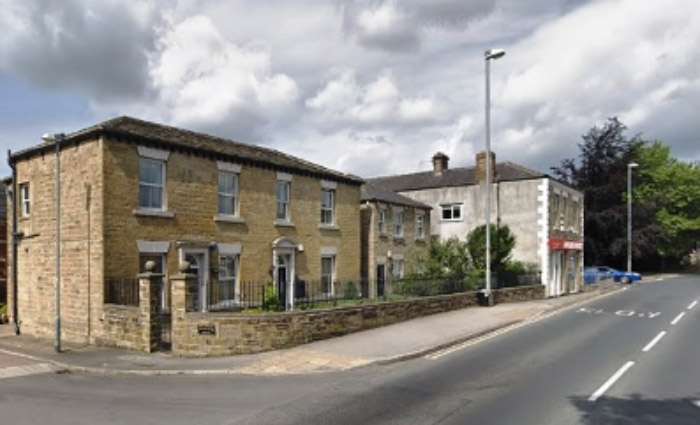
Above; Mallin House on Queen Street Ossett (now two dwellings)
In 1892 Kate (Catherine) Wilby (born 1866) married John William Cussons, a manufacturing chemist born in Louth, Lincolnshire in 1868. John William was the son of Thomas Tomlinson Cussons, who in the early 1880s opened Cusson’s chemist shop in Station Road Ossett.
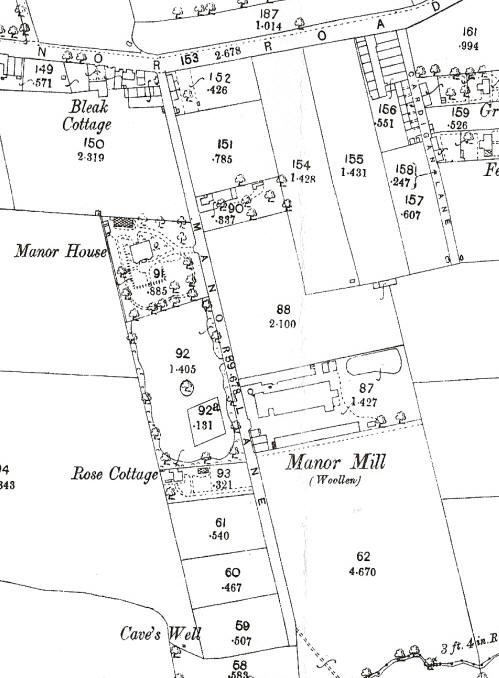
Above: 1890 Map showing Manor House and its proximity to Manor Mill and Bleak Cottage.
Above: Mark Wilby was a partner with David Pickard at the 1854 built Manor Mill. This photograph is from the 1970’s when it was owned by Windsor & Firth Ltd. The Mill was vandalised on 29th March 1971 & demolished on 8th February 1975.
By 1901, widower Mark Wilby, a retired Woollen manufacturer, was 73 years of age and living at Manor Villa. Four of his daughters, two of whom are married, gathered at Manor House on census night; Jane Ann Smith(48), Eliza Wilby(45), Emily Wilby(42) and Catherine Cussons (34). Jane Ann Phillips is a mile away at West Wells and Frederick Wilby is 300 yards away at Prospect House, Station Road. A family gathering it seems. Did Mark Wilby have something to announce? Perhaps he was about to sell Manor House?
Four years later in 1905 Ossett born John Thomas Marsden, who became Ossett mayor in 1907/08 when the new Town Hall was opened, was living at Manor House after Mark Wilby had moved to live at Southport where he died in 1912 aged 85. In 1910 the garden and grounds of Manor House included a “reservoir”, greenhouse, vinery, stable, coach house and wood shed. In 1913‐14 J.T. Marsden was still owner of Manor House and he was living there when he died in August 1920, aged 67. By 1927 Manor House was occupied by the “Misses Marsden”, believed to be the unmarried daughters of John Thomas Marsden.
Since its construction in 1870 until about 1930 the Manor House on Manor Lane, latterly Cavewell Gardens, was home to the two esteemed Wilby and Marsden families. In the late 1950’s a third equally esteemed local family, the Brooks of Sowood Farm, took up residence at the Manor House. Bennett Brook and his wife Mabel (nee Wormald) lived there before moving to live on Queens Drive. Bennett Brook owned and for the whole of his adult life, military service permitting, worked the 17th century Sowood Farm. Bennett was also the grandson of Bene’t Brook (1825-1913) who was elected Chairman of the Local Board in 1889, the year before Ossett was granted the Borough Charter.
Alan Howe from research in 2010
Dating from 1864 Bleak Cottage located on Manor Road, Ossett is another mid 19th Century property of interest and distinction. This is a summary of the history of Bleak Cottage; the full history researched and written by Alan Howe can be seen at Ossett Heritage Here
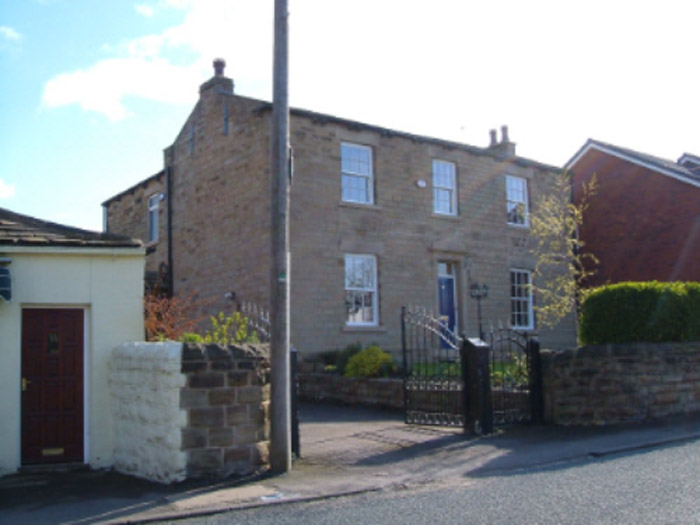
Above: Bleak Cottage, Manor Road in 2005
In 1813 Joseph Scott, Ossett yeoman and book keeper, was allotted land by the Ossett Inclosure Act. Bleak Cottage was to be built on this land. Joseph lived nearby and in 1833 he sold 18 perches of that land (about 0.125 of an acre) to Nathan Mitchell. Born in Ossett in 1799Nathan was a farmer and a landed proprietor, living on nearby Giggal Hill.
There is some evidence of earlier buildings/dwellings on what was to become Bleak Cottage and in 1841it appears to have been the site of two adjoining cottages which was home to David Wilby (1787-1841), a clothier living with his wife Mary (nee Illingworth), seven children and a servant. Living next door was Randolph Wilby (1797-1868), a clothier with his wife Mary (nee Scott, ) also with seven children.
The old cottages on the site were still there in 1861 shortly before construction of the grander Bleak Cottage began. Evidence indicates that Nathan Mitchell, farmer and later coal dealer, acquired a further two acres of land thereby assembling a significant frontage on to Manor Road. In 1864, Nathan Mitchell sold his house at Giggal Hill and began the construction of the present Bleak Cottage but his tenure was to be short and he died in 1870 aged 71. With no children Nathan bequeathed it to his nephew James Mitchell (born 1813) who held the land and, it is believed, the ownership of Bleak Cottage until his death in 1893.
In 1871 Bleak Cottage was occupied/tenanted by Albert Speight, (born 1846), a mungo and shoddy manufacturer, living with his wife Sarah-Anne (nee Atkinson) and their young daughter. Albert, the son of John Speight, the proprietor of Northfield Mill, Field Lane (Church Street), Ossett. Sadly Albert died in 1876,aged 30 in 1876. By 1881, Bleak Cottage was home to Charles William Abell, a bank clerk, aged 31 years,his wife Elisabeth and a young son Percival Edwin. In common with most residents of Bleak Cottage at this time the family had a servant living in.
The Abell family tenure at Bleak Cottage was also short-lived, and by 1891, the couple appear to have separated. In that year Charles Abell was lodging at Brussels Hall, Leeds, a boarding house for the working classes. The proprietor was Mr. T. Parker, described as a “Cocoa House Proprietor”. In the same year Charles Abell’s wife Elisabeth was living and working in Shipley, a “monthly nurse” in the house of John Coates, a baritone vocalist and textile worker.
Before he died in 1870 Nathan Mitchell had sold a significant area of land to the south of the Bleak Cottage location to mill owner, Mark Wilby who in the late 1860’s built his new home, the grand Manor House (aka Villa), opposite his jointly owned Mill on Manor Lane. In 1891 Wilby’s son in law, Alfred Farrer Smith and his wife Jane Ann(nee Wilby) were living as tenants at Bleak Cottage.
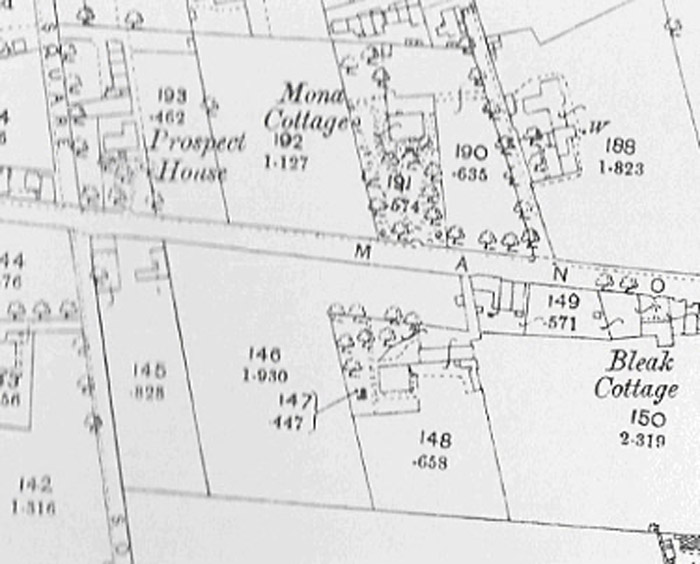
1890 Bleak Cottage & grounds. Junction of Manor Road & Station Road on left.
Between 1870 and 1893 Bleak Cottage was owned by Nathan Mitchell’s nephew James Mitchell who died in 1893 aged 80 years. In accordance with Nathan Mitchell’s Will of 1864 James left most of his estate, including Bleak Cottage, to his son, Godfrey Mitchell (1845-1931), a railway guard who lived most of his life in Balby, Doncaster .Like his father, James, Godfrey appears not to have lived at Bleak Cottage. Instead he was content to use the dwelling as collateral to raise capital and to let the fine and substantial dwelling to whosoever could afford the rent. The borrowed capital was only paid off after Godfrey’s death in 1931 when Bleak Cottage was sold by his sons and executors in 1934.
The Census for 1901 is inconclusive as to the occupier of Bleak Cottage, but between 1905 and 1915 it was rented by Wilson Briggs, Rag Merchant, who ran a rag warehouse on Manor Road closer to the Sowood Lane junction. That warehouse, Manor Foundry, was built in the 1840s by John Humble, a manufacturing chemist and Nathan Mitchell’s brother in law; Wilson Briggs also owned the New Mill at Healey which is still operational (2021).
At some uncertain time, perhaps around the turn of the 20th century, Bleak Cottage was divided into two separate dwelling houses. There were two separate entrances and two separate staircases. The house was later converted back into one larger house, but there remains evidence of the conversion work and the old room divisions.
In 1915 Bleak Cottage was rented by rag merchant John Walker and his wife Annie Ada who lived there with their children Marian (born 1895) and Clifford (1897). In July 1918 Marian Walker, aged 22, was engaged by the Voluntary Aid Detachment (VAD) to support injured servicemen at the White Rose Hospital, Heath, Wakefield. Sadly on 5th November 1918 Clifford, aged 21, had died of influenza in a French Hospital whilst serving his country in WWI. On 1st January 1921 Marian of Bleak Cottage wed former soldier Thomas Evans at the New Wesleyan Church, Ossett. In 1939 the couple were living at 70 Manor Road with their three children, a short distance from her former home at Bleak Cottage.
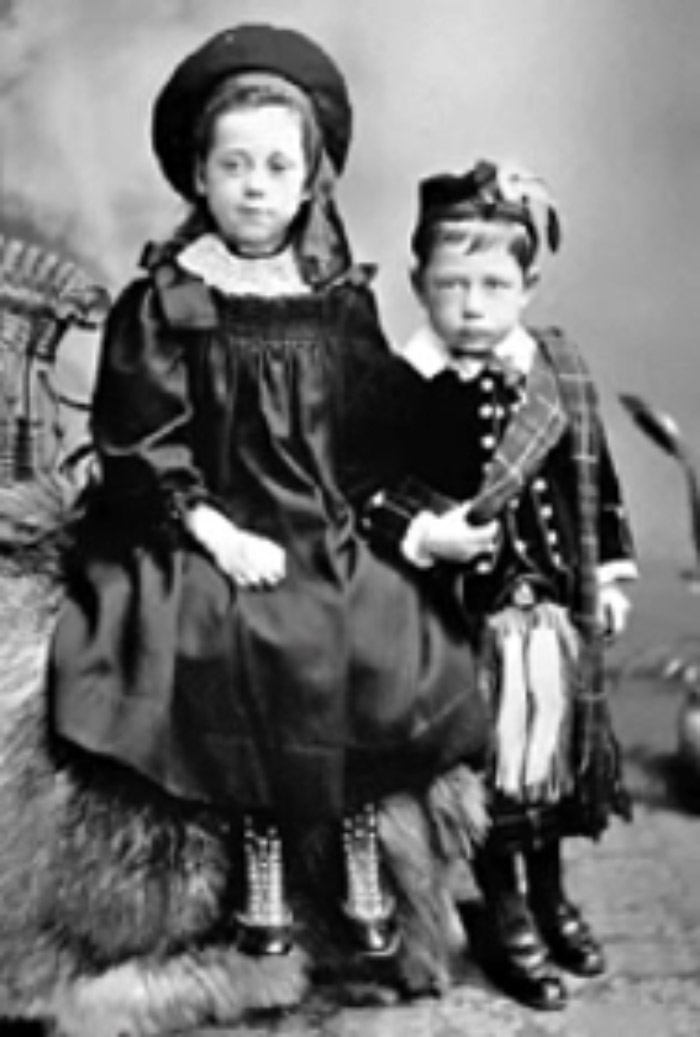
Marian (born 1895) and Clifford Walker (1897-1918) in a picture taken about 1902.
Biographies for Marian Walker and Clifford Walker can be seen here on Ossett Heritage
Godfrey Mitchell inherited Bleak Cottage from his father in 1893 but he had never lived there. Godfrey died in 1931 and in 1934 his sons and executors sold the house and the 2 acre close of land to Mrs Florence Annie Bedford of Hope Street, a short distance from Bleak Cottage. The house and close of land was rented to Joseph W. Crosland, a poultry dealer, and his wife Mary (nee Raynor). The couple were still living at Bleak Cottage, 42 Manor Road in 1939; with them in the household was partially blind Agnes Mitchell, the niece of Nathan Mitchell.
In 1953, Mrs Bedford (another owner who never lived at Bleak Cottage) sold the land behind the house to Ossett UDC for housing. In 1964, she sold the rest to retired farmer, Harry Mitchell of nearby Sowood Cottage who was still there in 1969. Joseph Crosland was also still at Bleak Cottage, suggesting that the dwelling was still divided to provide two dwellings. Harry Mitchell, born 1903, had lived the whole of his life at Sowood Cottage situated at the junction of Manor Road and Station Road. Sowood Cottage was built by his great grandfather, Joseph Mitchell, who was the brother of Nathan Mitchell who built Bleak Cottage in 1864. See more about the history of Sowood Cottage here.
It is believed that Harry Mitchell subsequently sold Bleak Cottage to Mary Lister who also owned the hairdressing salon at 100 Manor Road, next door to Bleak Cottage. A couple called Pinchbeck had the property from about 1987 followed by Michael and Annette Smith in 2001. The present owners (2009) bought Bleak Cottage in 2004 after some renovation work was carried out.
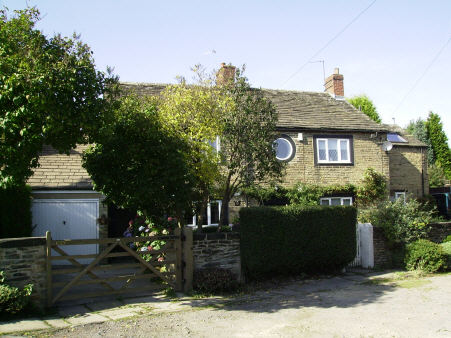
Alan and Pat Howe live in one of a pair of semi-detached cottages on Haggs Hill Road and their son-in-law and daughter, Ashley and Emma Wild live in the other with their son Jack. It is thought that the cottages were at one time a farmhouse built by Joshua Haigh, a local landowner who lived at Longlands House in Ossett. In the deeds, Joshua Haigh is described as a woolstapler, gentleman landowner and county yeoman. He purchased the land for the farmhouse from Edmund Heron on the 23rd November 1744. The deed to the land refers to ‘two butts of land lying in the said East Field between a close of the said Joshua Hepworth called Lights Brigg Pighles on the south and the land of Mr. Dawson on the North.’ The land on which the farmhouse was built was copyhold and this required the consent of the Lord of the Manor of Wakefield prior to the sale. The transaction between Joshua Haigh and Edmund Heron was agreed at a ‘Court Baron’ held at Wakefield on the 18th January 1744. It is thought that the original farmhouse building was built by Haigh for his son, also Joshua Haigh who was born in 1739. Joshua Haigh senior died in 1784 and it is likely then that his son would have vacated the farmhouse or cottages to take up residence at Longlands House, which was off the Halifax to Wakefield turnpike road at Flushdyke.
The earliest references to the cottages is that shown in a Valuation Record for Ossett in 1774, which was ultimately used to raise money from taxes for the war with France during the American Revolution (after the French offered support to the Americans). The property is shown in the valuation record as being in the ownership of Joshua Haigh junior and is described as ‘House and Lights Bridge Pighle‘. Lights Bridge refers to the location of the property in a part of Ossett then known variously as Lights Bridge, Lights Brigg, Ossett Lightside, and occasionally as Low Common or Low Common End. ‘Pighle‘ means a small area of land. The value of the property for tax purposes was £1 10s 0d, suggesting that it was larger than some of the other properties on Low Common. The record indicates that the house wasn’t occupied by tenants, and it is more likely that the Haigh family occupied the building themselves. In 1773 Joshua Haigh was a woolstapler in Ossett. A woolstapler would buy raw wool and take it (by packhorse) to the homes of workers where it would be hand combed, spun into yarn and woven into cloth on handlooms. The finished product would be then collected by the woolstapler and sold at local Piece Halls in Bradford, Halifax, Leeds or Wakefield
The Land Tax record of 1788 appears to show a change in the occupation of the building and it is likely that it was now occupied by tenants for the first time. Possibly, it was at this time that the farmhouse building was divided into two separate cottages and used by the tenants for weaving cloth. The Land Tax records show that a Mark Pickard (born 1755 married to Hannah and with eight children) was living in a property on Ossett Low Common that was owned by Joshua Haigh, which was almost certainly the farmhouse or cottages. After Mark Pickard had died, followed by his widow Hannah, who died in the 1830s, their son Robert Pickard (born 1786) and his wife Nancy lived in one of the cottages with their nine children. The Pickard family were tenants and later owners of the cottages for close to 200 years, between approximately 1774 and 1945. The Pickards, living in Low Common, Ossett were traditionally weavers and woollen cloth workers and in 1841, there were 45 Pickards living in close proximity as members of six separate families.
Below: Rear of the cottages showing the now blocked door entrances at the rear first floor level. It is thought that these doorways were ‘piece’ or ‘taking in’ doors, which were set at first floor level in an exterior wall to facilitate the loading in and out of bulky materials like wool and yarn or finished items such as kerseys and broadcloths, which weighed 66lbs. A wooden walkway would have extended from the door to the raised land behind the cottages.
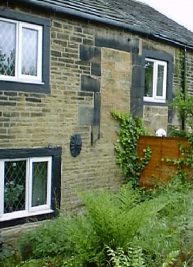 After Robert Pickard died in 1867 at the age of 81 from “general decay and pneumonia“, the tenancy was taken on by one of their sons, Isaac Pickard (born 1818), a cow keeper (dairy), and now with his second wife Eliza. The couple lived at the cottages with their nine children until Isaac’s death in 1886, aged 68. Once again, the tenancy was taken on by one of the Pickard family, this time by Isaac’s son, also Isaac Pickard (born 1864). However, Isaac Pickard junior, who had been a weaver and a dealer in malt, but by then was a farmer and market gardener, went one step further than his ancestors and bought the cottages with 4.5 acres of land for £450 in February 1918 from the Misses Steele, who were by now the owners of the property. There were actually four separate, but connected pieces of land, in the conveyance. ‘Ikey Pickard’s Passage’, in Isaac’s ownership, linked the cottages and their garden to two larger pieces of land (of about 3 acres in total) known as Wheatley’s Closes, which on modern maps would be located on the opposite side of Queens Drive near to the Two Brewers pub. The final area of land stood opposite the cottages on the other side of what was then South Parade. ‘Ikey Pickard’s’ passage is now the entrance and vehicle access to the house known as 170A, Queens Drive, which was built in the 1980s.
After Robert Pickard died in 1867 at the age of 81 from “general decay and pneumonia“, the tenancy was taken on by one of their sons, Isaac Pickard (born 1818), a cow keeper (dairy), and now with his second wife Eliza. The couple lived at the cottages with their nine children until Isaac’s death in 1886, aged 68. Once again, the tenancy was taken on by one of the Pickard family, this time by Isaac’s son, also Isaac Pickard (born 1864). However, Isaac Pickard junior, who had been a weaver and a dealer in malt, but by then was a farmer and market gardener, went one step further than his ancestors and bought the cottages with 4.5 acres of land for £450 in February 1918 from the Misses Steele, who were by now the owners of the property. There were actually four separate, but connected pieces of land, in the conveyance. ‘Ikey Pickard’s Passage’, in Isaac’s ownership, linked the cottages and their garden to two larger pieces of land (of about 3 acres in total) known as Wheatley’s Closes, which on modern maps would be located on the opposite side of Queens Drive near to the Two Brewers pub. The final area of land stood opposite the cottages on the other side of what was then South Parade. ‘Ikey Pickard’s’ passage is now the entrance and vehicle access to the house known as 170A, Queens Drive, which was built in the 1980s.
The original owner of the cottages and land, Joshua Haigh had several children, but they all died childless. In 1880, the cottages were left by the Haighs to the Wheatley family who were related to them by marriage. Charles Wheatley J.P., a Mirfield colliery owner and gentleman landowner had no direct heirs and when he died in 1900, he left all his property (including the cottages) to his great niece, Eleanor Steele, wife of Adam Rivers Steele of Loddington Hall in Leicestershire. She died in 1910 and subsequently left the cottages to her two unmarried daughters Camilla and Mary Steele.
Isaac junior was the last of the Pickard family to live at the cottages and he died in 1945 (from a heart attack and chronic asthma) in the same cottage that he had been born in 81 years earlier. Isaac Pickard married Emma Quarmby (1865-1907) in 1890, but the couple had no children and the cottages passed to his “natural” daughter, Nora Quarmby (1898-1946), the daughter of his sister-in-law, Mary Ann Quarmby (born 1863). Mary Quarmby and her daughter Nora lived in the cottages with Isaac and his wife Emma from about 1900. When Emma Pickard died in 1907, Mary and Nora Quarmby remained at the cottages and it was Isaac who brought up Nora and she subsequently looked after Isaac in old age.
In July 1935, Nora Quarmby married John Harrop at the Springfield Independent Chapel in Dewsbury. The couple then went to live at number nine, where John Harrop carried on the market gardening business in his own right. Sadly, Nora died in November 1946, and the properties transferred into the ownership of her husband, John Harrop continued to live at number 9 until his death on 20th February 1980. As the properties came under new ownership, the large greenhouses behind number seven were demolished and the cottages were significantly modernised for life in the 21st century.
Meanwhile, three generations of the Hanson family were to live at number 7, Haggs Hill Road. Bertram Owen Hanson, born in 1897, married Beatrice Lucas in 1921. Shortly after their marriage in Wakefield, the newly married couple moved into number 7, where they raised a family of four children: Vernon Hanson born 1924; Eileen Hanson born 1927; Valerie Hanson born 1930 and twins Geoffrey & Margaret Hanson born in 1933, although at the time the Hansons were living in South Street, Ossett and not at Haggs Hill Road..
Vernon Hanson was to take on the tenancy of 7 Haggs Hill Road after his parents died and he lived there with his first wife Gladys Cartwright whom he married in 1946 and then later his second wife Elsie Oldroyd whom he married in 1966. Vernon and Gladys Hanson had a son Michael John Hanson who was born at 7, Haggs Hill Road in 1950, like his father before him.
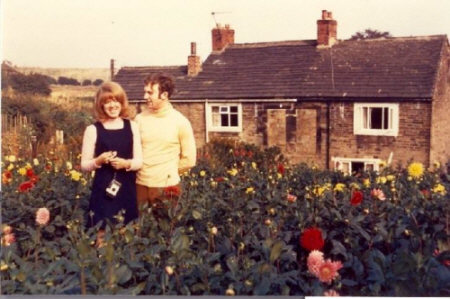
Above: Michael Hanson (1950-1989) and his wife Norma (1949-2005) among the dahlias in the garden of 7 Haggs Hill Road in the early 1970s, before a large part of the garden was sold off to build a new house at 5 Haggs Hill Road. Michael was the last of three generations of Hansons to live at the house. Thanks to Barry Hanson, the youngest son of Michael and Norma Hanson for the photograph. The photograph clearly shows the s blocked up doorways which were ‘piece’ or ‘taking in’ doors to facilitate the loading in and out of bulky materials like wool and yarn or taking out finished items such as kerseys and broadcloths. The upper floor of the cottages would have been used by self-employed weavers in the 19th century and wooden steps would then have led up to the access doorways.
In 1962, Vernon and Elsie Hanson bought 7 Haggs Hill Road from John Harrop and later (about 1989) Vernon sold part of the large garden of number seven to a developer who was to build 5, Haggs Hill Road on the land.
In the 1920s, Ossett Borough Council compulsory purchased the three or more acres of land referred to as ‘Wheatley’s Closes’ for the development of Towngate. Wheatley’s Closes would have had a significant value as prime residential building land. Sadly, that financial benefit would have accrued to the Council and not to Isaac’s Pickard’s family.
Scott’s Yard is situated on Manor Road Ossett adjacent to The Victoria Public House. Over the years this area has been known variously as Ossett Common Side and by several spellings of the curiously named Giggal Hill (Giggle Hill and Jiggle Hill). It is likely that this name was earned from the family Giggal who owned land and property to the north of Manor Road at the junction with The Green. This area was known as Giggal Hill Bottom.

In 2007 the present owners of ScottsYard, Richard and Rachel Spurr, purchased the land and the dwelling standing there, exactly 200 years after the land first came into the possession of the Scott family in 1807. The existing 2008 property comprises three earlier dwellings, built in the 19th century or earlier and a 1960’s extension. Before 1807 the land was owned by Isaac Wilby Clothier. The Ossett Survey of March 1774 shows land and property (described simply as ‘..housing’…and ‘croft’) ownerships in the name of Isaac Wilby who was born in Ossett in 1743.Isaac’s father was also called Isaac (born 1717) and Wakefield Manorial Court Rolls suggest that he may have acquired the land from his brother Joseph in 1750. Isaac’s ancestors can be traced back to the birth of Jonathan Wilby of Ossett in 1653 and examination of early 18th century Court Rolls suggest the family may have owned the land in the 17th Century.
The land was copyhold and required the consent of The Lord of The Manor of Wakefield to any transfers of ownership or significant tenancies. In 1806 Isaac Wilby died and left his estate to his 6 children. His son David Wilby (born 1765) inherited Scott’s Yard which, along with adjacent ownerships, was described in Isaac’s 1802 Will as ‘all that copyhold messuage dwellinghouse or tenement situate at Ossett Common Side aforesaid where I now dwell with the new erected Barn shop and the remainder of my Croft together with all the other Outbuildings rights members priviledges [sic] and appurtenances thereto belonging except and always reserved out of this devise unto my said sons John, Jonathan and Benjamin….the priviledge [sic] of fetching water from the draw well to and for their own use..’
The Wilby family were clothiers with interests in the Fulling Mill and Dyeworks at Healey. By the beginning of the 19th century this branch of the family also owned a significant amount of land on Ossett Common Side (on both sides of Giggal Hill). This included the area which was to become known as Scotts Yard, then a croft with a range of outbuildings and a new erected barn. The site may also have included a dwelling or dwellings and it is certain that three of Isaac’s sons, David, Benjamin and Jonathan were living there or thereabouts in 1810. The Ossett Inclosure Act of 1807 and the subsequent Order of 1813 shows the family in, or close to, the Yard and maps show buildings and premises on and adjacent to the site which are described as ‘ancient’ suggesting that they would date at least to the 18th century .An area owned by Charles Scott (later known as Happy Land) is described as being ‘bounded on the west by ancient Inclosures now or late belonging to .… David Wilby’ This was Scott’s Yard.
David inherited the yard in 1806 but in 1807 he sold this and other land and property he had inherited from his father , to Joseph Scott, Book Keeper and Yeoman of Ossett. Joseph was born about 1750 and came from a family of Ossett Clothiers who vied with the Wilby family and others to become the major land owners on Giggal Hill and Middle Common. The family can be traced back to Benjamin Scott of Ossett who was born about 1695. It seems likely that the Scotts did not live in the Yard preferring the area to the east known then as Ossett Middle Common and later as Park Square. The family had land and property here and in the area now known as Fairfields. The Ossett Inclosure Order of 1813 shows Joseph living on Middle Common Road (at the junction of Station Road and Park Square). His brother Charles lived on the opposite side of Middle Common Road (Station Road) in a property on Scott Road.
In 1837 Joseph Scott left Scott’s Yard to his brother David’s four surviving children and over the next 20 years David’s son Samuel becomes sole owner of the site. This period is one of the most active in the history of the Yard with evidence of housing development elsewhere on Giggal Hill and the Victoria Public House, built in the late 1850’s.The 1850 O.S. map shows three buildings on the site. An 1859 conveyance, in the possession of the present owners, makes refers to a barn ‘now pulled down’ and five dwellings. This 1859 conveyance transferred the Yard from Samuel Scott to his only son Henry Castile Scott. It is likely that the five dwellings referred to in this Deed includes at least one of the three dwellings which now comprise the existing building known as number 7 Scott’s Yard.
 Plan showing the layout of properties in Scott’s Yard (probably) between about 1870 and 1970. Numbers 6,7 and 8 are now(2008) combined into a single dwelling. The area outlined in red was sold to J & M Asquith Ltd in the early 1970’s.
Plan showing the layout of properties in Scott’s Yard (probably) between about 1870 and 1970. Numbers 6,7 and 8 are now(2008) combined into a single dwelling. The area outlined in red was sold to J & M Asquith Ltd in the early 1970’s.
In 1891 a Wakefield Court Baron document refers to five dwellings and the Ordnance Survey map in the mid 1890’s shows eight dwellings on the site in the positions shown above.
Between 1861 and 1901 several families lived in, or close to, the Yard including the family of Nathan Wilby (junior and senior). Nathan was the great grandson of Isaac Wilby who owned the site in 1774. Even though Isaac’s son, David, sold the site to Joseph Scott in 1807 the Wilby’s were still living here almost a hundred years later. Nathan Wilby died in 1916. There is no evidence that the Scotts lived here at any time between 1841 and 1901 and it is probable that Joseph Scott purchased the site for its investment potential.
In 1859 Henry Castile Scott inherited the Yard, five dwellings, from his father Samuel. By the 1890’s eight dwellings are providing homes for some 39 men women and children. Henry Castile Scott, who lived at Mona Cottage (Park Square fronting onto Manor Road), died in 1912 leaving Scott’s Yard and Mona Cottage to his four surviving children. The last surviving child, Anna Louisa Scott, died in 1943 and Scotts Yard was sold to Alfred Ernest Ellis thus bringing to an end some 136 years of ownership by the Scotts.
By1944 six dwellings remained and it is likely that numbers 4 and 5 had been demolished by this time. It is also probable that numbers 1,2 and 3 were demolished in the 1960’s when other housing clearance was taking place on the Giggal Hill part of Manor Road. The 1944 deed is the first to record the site as ‘Scott’s Yard’ In the mid 1960’s an extension was added to the remaining buildings (numbers 6,7 and 8) and this is the configuration which remains in 2008.
Following Mr Ellis’ death his executors sold the site to Isaac and Joan Adeline Hughes in tranches over a 20 year period from 1951. The Hughes sold the site to Robert Dale in 1986. It was sold again in 2002 and purchased by Richard and Rachel Spurr in 2007.
And so, the property known as Scott’s Yard appears never to have been the home of the Scott family even though they owned the site for 136 years between 1807 and 1943.On the other hand the Wilby family who owned the site until 1807 lived here or hereabouts for at least 127 years between 1774 and 1901. Indeed they probably owned the Yard before 1700 and stayed beyond 1901 (Nathan Wilby, who lived here in the second half of the 19th century, died in 1916)
The Scott and the Wilby families were clothiers by trade and by the early 1800’s it seems that the Wilbys were near the end of a dynasty whilst the Scotts were continuing to build and expand theirs. Where once they were owners the Wilby family became tenants of the family to whom they had sold Scott’s Yard in 1807. Nothing lasts forever and by 1943 the Scotts too were no more thus bringing to an end 250 years or so of ownership by the two families.

Above: Scott’s Yard before the demolition of the majority of the old cottages. Numbers 1, 2 and 3 Scott’s Yard can be seen on the right of this picture.
Sowood Cottage is situated on Sowood Lane at the junction with Station Road and Manor Road . In 1911 an eight year old Harry Mitchell lived there with his parents Thomas William Mitchell (born 1866) and Fanny Mitchell (nee Proctor born 1867) formerly of Roecliffe near Boroughbridge, North Yorkshire. In 1964 Harry Mitchell, aged 61 years purchased Bleak Cottage, Manor Road from Florence Annie Bedford. By then Harry was a retired farmer though still dabbling in land transactions elsewhere in Ossett. No doubt, when he bought Bleak Cottage he would have been aware that it had been built exactly 100 years earlier in 1864 by his great grandfather’s brother, Nathan Mitchell.
The history of Sowood Cottage is a Mitchell family affair. Harry Mitchell was the son of Thomas William Mitchell (1866) and Fanny Proctor. Harry’s grandparents were Thomas Mitchell (1827) and Sarah Smith and his great grandparents were Joseph Mitchell (1799-1835) and Ann. Three or maybe four generations of the Mitchell family lived at Sowood Cottage on Sowood Lane formerly known as Denton Lane.
 Harry’s father, Thomas William, a cart agent by trade was the tenth of eleven children born to Harry’s grandparents, Thomas, born 1827, & Sarah (nee Smith). In 1841 Thomas, a farmer and clothier lived here with his widowed mother, Ann, and his siblings.
Harry’s father, Thomas William, a cart agent by trade was the tenth of eleven children born to Harry’s grandparents, Thomas, born 1827, & Sarah (nee Smith). In 1841 Thomas, a farmer and clothier lived here with his widowed mother, Ann, and his siblings.
Thomas’ father, Joseph Mitchell (1799-1835), left Ann a widow aged 31 and with five children under the age of eight. Joseph was interred at the Ossett Congregational Church Burial Ground at Dimple Wells and was one of eighteen Mitchells whose bodies were exhumed in the late 1960’s to make way for housing development. More than one hundred exhumed remains were re-buried at Gawthorpe Burial Ground without ceremony.
The history suggests that this Mitchell family were in Sowood Cottage from 1841 and the likelihood is that they were here earlier than that. In 1807 the land upon which the house is built was owned by Isaac Wilby. The Ossett Inclosure Order map does not appear to show a structure here in 1813 and it is supposed that Sowood Cottage was perhaps built shortly after that date. Perhaps it was built for Joseph Mitchell (born 1799) who married Ann in about 1825 and who had their first child, Mary, in about 1826 The 1813 Order map is shown overleaf and shows the land, at the junction of Sowood Lane and Manor Road, in the ownership of Isaac Wilby. It will be seen that no structures appear on the land at that time. Further along Sowood Lane is land in the name of Thos. Mitchell. This is probably Joseph’s grandfather Thomas Mitchell born 1775 who, of course, was also Nathan Mitchell’s grandfather.
In 1961 the occupier of Sowood Cottage was Arthur H. Shaw and it is possible that Harry Mitchell may have sold Sowood Cottage to fund his acquisition of the grander Bleak Cottage in 1964. The sale brought to an end almost 150 years occupancy by the Mitchell family. Sowood Cottage was sold again in November 2009 when it was acquired by Ronald James Ramswell who remains the current owner.
A Doctor’s Practice in Ossett 1795 to 1976
with particular reference to the Greenwood family1
There have been three dwellings in Ossett with the name Sowood House and a fourth with the name, Sowood Manor House. This latter dwelling built on Park Lane, the road running from Storrs Hill Road into Ossett Academy, was built in 1684 and demolished in the late 1950’s. It is believed that it may once have been the Sowood Manor House – the home of the Lord of the Manor of Sowood.
The dwelling known today as Sowood Farm was also known as Sowood House for much of the 19th Century. The listed Sowood Farm House which dates from 1689, still stands there today, probably on the site of an earlier building. The two remaining dwellings which carry the name, Sowood House, in the 21st Century include one which was built about 1875 and is situated off Sowood Lane near the junction with Manor Road.
The remaining dwelling, and the subject of this research, is the Sowood House which stands on The Green at the junction with Healey Road (once Healey Lane). Today Sowood House on The Green, is a Hair and Beauty Spa but for much of its existence it was a Doctors’ Surgery, Dispensary and Operating Room.
 Above: Sowood House pictured in 2007.
Above: Sowood House pictured in 2007.
Sowood House is believed to date, in part, to the early 18th Century but its history as a home and workplace for generations of Doctors dates from, a little later, in the 1790’s. It was then that John Greenwood (1776-1831) and his wife and cousin, Jane Greenwood, were recorded in Ossett and
shortly after 1801 he purchased Sowood House from the administrators of bankrupt clothier, John Wilson.
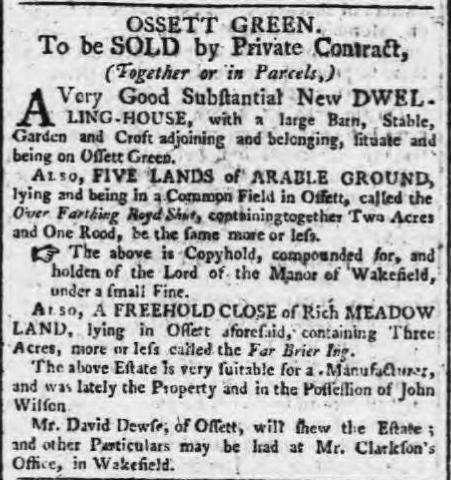 Notice in The Leeds Intelligencer 2nd March 1801
Notice in The Leeds Intelligencer 2nd March 1801
As early as 1795 John Greenwood was practising medicine in Ossett, quite possibly at Sowood House, but, apart from his acquisition of the House shortly after March 1801 the first documentary evidence appears in 1821 and 1822 when he was described as a surgeon.
John Greenwood’s brother, Richard married Elizabeth Liversedge in 1798 and as a result of the marriage the Greenwood family became related to the Haigh and Wheatley families. Joshua Haigh and Charles Wheatley were key players in 18th and 19th Century Ossett land and property ownership. The Greenwoods own lineage was also well documented. In the 1709 Wakefield Manor Estate Book where mention was made of Abraham and Daniel Greenwood. 100 years later John Greenwood named two of his sons Abraham and Daniel suggesting the family’s long existence in this part of Yorkshire. In 1775 John Greenwood owned 5 acres of Ossett land, Medley Sands, on the River Calder, close to Healey. This was an earlier John Greenwood than the one born in 1766 (possibly his Uncle and possibly Jane’s father who was called John) but it indicates that the Greenwoods were in Ossett by 1775. The 1795 Land Tax mentions, for the first time, a Mr Greenwood, the title is applied to a person of some standing. It is known that John Greenwood was practising medicine in that year.
John Greenwood and his wife, Jane, had seven children from their marriage and the eldest surviving son, George Greenwood (1805-1868) took over the Sowood House practice when his father, and his mother, died in 1831. It appears that John Greenwood left Sowood House and some land at Farthing Royd (Healey Lane) to George and his brothers, Thomas and Daniel, on his death in 1831. It is also possible that in 1839 George took a mortgage from a William Stewart, solicitor of Wakefield, to buy out his brothers’ interests so that George became sole owner.
In 1825 George had been admitted to the Royal College of Surgeons and also became a Licentiate of the Society of Apothecaries. He is first described as a surgeon practising at Sowood House in 1830 and thereafter in Censuses and Trade Directories until 1866 when the practice was described as George Greenwood & Son. However George was living elsewhere on The Green in 1861 and he died in 1868 aged 63 years. Over the years he had established a significant land holding and the 1843 Ossett Tithe Awardrecords him as the owner of more than 50 acres in the Healey Lane and Sowood area.
It is probable that George’s first child, John William Greenwood (1833-1904), participated in his father’s practice from 1856 when he was admitted to the Royal College of Surgeons and became a Licentiate of the Society of Apothecaries. In 1855 he had also became a qualified midwife and by 1871 he was described as a General Practitioner, Midwife and Apothecary.
John William married Mary Thompson in 1860 and at least five children were born to the marriage including four sons. George Spencer Greenwood was the eldest, followed by William, Bransby, Claude and Nora. George and William became doctors, Bransby a solicitor and Claude a Civil Engineer. All of the children were born in the 1860’s and all remained in Ossett after achieving their qualifications. Bransby lived at the Greenwood owned dwelling, The Cottage, and Claude lived on Storrs Hill. By 1881 John William Greenwood had been appointed Medical Officer of Health for Ossett.
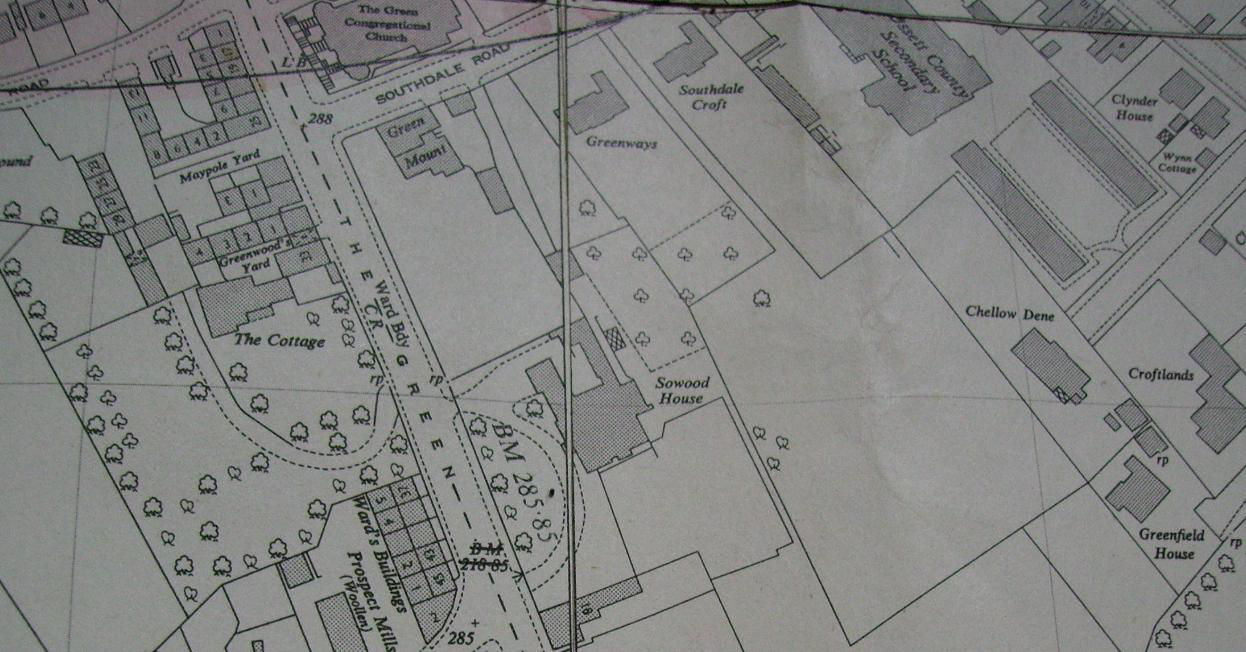 Above: Map (1960’s) showing Sowood House, Green Mount, The Cottage & Greenwood’s Yard12
Above: Map (1960’s) showing Sowood House, Green Mount, The Cottage & Greenwood’s Yard12
In 1892 John William ventured into land and property acquisition and purchased the adjacent Green Mount and almost 4 acres of associated land which was situated behind Sowood House. In 1895 he paid £21 to the Lord of the Manor of Wakefield to enfranchise his copyhold land in Green Mount and Sowood House. Effectively this converted his copyhold interest into a freehold interest in the properties and the Lord of the Manor would no longer hold sway over what John William or his heirs did with the properties.
John William Greenwood, by then a widower, was living at Sowood House (even though he had moved to Scarborough in about 1893) in 1901 but the head of the house was his son, George Spencer Greenwood. In 1904 John William died, aged 71, in Scarborough at his spinster sister, Alice Greenwood’s, home address.
John William’s two elder sons, George Spencer Greenwood (1862-1905) and William Greenwood (1863-1911) had worked in the practice since qualifying in the late 1880’s and, like their father, they had achieved high public office with the local borough. By 1893 George Spencer Greenwood was the Medical Officer of Health to the Corporation and William Greenwood was the Medical Officer and Public Vaccinator, Ossett District, Dewsbury Union.
The early 20th Century was unkind to the Greenwood family. John William, died in July 1904 and his only daughter, Nora, aged 36 years, died five weeks later in early September 1904. A year later, in October 1905, George Spencer Greenwood, a bachelor, died, aged only 43. His death may have been unexpected since he died without making a Will.
The eldest surviving son and only remaining Doctor in the family, William Greenwood, continued to run the practice from Sowood House and in 1907 he was joined by Dr W.L.R. Wood. He married his cousin, Alice Alford, in late 1905, but William died in January 1911, aged 48 years, leaving a young widow and four daughters, including twins, all under five years of age. Alice headed south with the children and later in 1911 she was living in Putney in a house which she had named Sowood. Staying with her was her nephew George Greenwood, aged 19, the son of Bransby and Lizzie Greenwood who was following in his father’s footsteps and studying Law in London.
Four generations of the Greenwood family had produced five doctors who served the people of Ossett for more than 110 years between 1800 and 1911 but this was the end of the Sowood House connection with the Greenwoods. Sowood House however had not finished with doctoring and in later 1911 the practice was taken over by Dr. William Louis Rene Wood (1877-1942) when Sowood House was leased to him.
Dr. Wood was born in Lorraine, France in about 1877 but had come to England before 1901 when he was living with his widowed mother, Salome, in Westminster, London and working as a footman. He was naturalised in 1898, qualified to practice as a doctor in 1905 and moved north and married Emily Gertrude Haslam, the daughter of a Baptist Minister in Gildersome in 1907. His mother died in Leeds in 1909.
During the war years, 1914-18 Dr Wood would have seen the terrible effects of that war on the men and women of Ossett. Those who went to war and returned wounded or gassed and those who remained at home but who had lost their loved ones. Then, in 1918, he would have dealt with the horrors of the Spanish Flu. There was, however, an interesting visitor to Sowood House in 1918 in
the form of a nurse from Sheffield called Constance Elliot Birks. Constance had worked in Dr Wood’s native France at a WW1 field hospital, run by the Scottish Women’s Hospital movement, near the front line at Royaumont near Paris.
Dr. Wood continued to rent Sowood House, until 1937 when, aged 60, he moved to live in Knaresborough where he died in April 1942. He had worked at Sowood House for 30 years. The House was still owned by the Greenwood family in 1937 having been inherited in 1911 by William Greenwood’s, widow, Alice who was still living in Putney. Perhaps as a result of potential purchasers or tenants, Alice Greenwood commissioned a condition survey of Sowood House in March 1937 and this was undertaken by local architect, Charles Kendall A.R.I.B.A. of 10, Bank Street, Ossett.
In 1937 Sowood House and the practice was occupied, either leased or purchased, by Dr. Stephen Brandon Stoker (1904-1979). He was accompanied by a practice partner, Dr. John Samuel Coad (1907-1966).
Stephen Brandon Stoker was born in Huyton Lancashire in 1904 the son of a Railway Clerk. He qualified at Edinburgh in 1927, married Jane Giles in 1935 and the couple had three daughters born between 1937 and 1944.
John Samuel Coad was born in Cramlington, Northumberland in 1907 the son of a Colliery cashier. He qualified at Durham University in 1933, moving to Ossett in 1937 and marrying local girl, Joyce Fearnside in 1940. They had two children, a son, Derek (born 1941) and a daughter, Pamela (born 1944). In 1946 Dr Coad established his own practice at Enfield House, Sowood Lane but also continued to work with Dr Stoker at the Sowood House practice. Sadly Dr Coad’s son, Derek, died in 1963 aged only 21 years and three years later, in 1966, Dr Coad died in Leeds General Infirmary, aged 59 years.
After Dr. Coad’s death, Stephen Brandon Stoker continued at Sowood House until about 1967/68, when he was about 63 years of age. Doctors D.M.Broughton and A.P. Mehrota appear to have taken over the practice but they do not appear to be at Sowood House after 1976. Dr. Stephen Brandon Stoker died three years later, in 1979, aged 75. John Samuel Coad had worked in the Sowood House practice for 29 years and Stephen Brandon Stoker for 30 years until 1967. Sowood House ceased to be a Doctors’ practice in about 1976, some 175 years after the first Doctor Greenwood established his practice in the early 1800’s.
In February 2004 Sowood House was sold to Gary Howard Price and Linda Amanda Price for £470,000. Subsequent planning applications for the building of a detached house on the (remaining) land to the rear of Sowood House were considered in 2005,2007,2008,2010 and June 2015. With the exception of 2008 all of the applications have been refused. In 2015 Sowood House continues to be operated as a Hair and Beauty Salon.
Loose ends
Until 1967 there remained some unfinished business for the Greenwoods and Sowood House. When William Greenwood died in 1911 the administration of his estate was granted to his widow, Alice Greenwood (nee Alford). Alice, who was also William’s cousin, died in Putney in 1952 without having fully administered the estate of William Greenwood. The task of finishing off William’s estate was left to William and Alice’s second daughter, Joyce, born 1908, who was known as Alice Joyce Greenwood.
Whilst Sowood House may have been sold by the Greenwood family to Stephen Stoker in about 1939 they reserved some land to the rear of the House. This had frontages on to Southdale Road and on to Lime Street to the north east of Sowood House. Three plots of land with a Southdale Road frontage were sold in 1937-1939. In 1967 the land with a Lime Street frontage was sold by Alice Joyce Greenwood to two times former Ossett Mayor, Edward Broadhead Nettleton, who lived at Greenfield House, Lime Street. In the 1970’s this land was developed to provide dwellings accessed from Lime Street. This transaction appears to have ended the Greenwood family connection with Sowood House and its associated land.
Alan Howe November 2015
Elder House was situated in extensive grounds of 1.5 hectares (3.6 acres), on Roundwood Road, off Teall Street in South Ossett, immediately to the east of The Little Bull Public House. It was probably built in the 1870s for the Bentley family who occupied the house for almost 70 years until 1939. It became the home of Thomas Wilby Bentley (1855-1926), who became Mayor of Ossett in 1909- 1911, and later the home of Wynyard Lionel Rose (1913-1989), a Doctor of Pathology. Elder House was demolished in the late 1980s or the early 1990s when consent was granted, in 1988, for the development of sixteen detached dwellings to be built on the Elder House estate. This is the story of the Bentley and Rose families who lived at Elder House for almost 120 years.

Above: 1905 Map showing Elder House (highlighted in red) off Roundwood Road facing the Baptist Chapel & Burial Ground on Baptist Lane.
William Bentley, a farmer and the son of a farmer, married farmer’s daughter, Elizabeth Wilby at Wakefield St John’s Church on 27th October 1853. In 1861, Elizabeth, a dressmaker, and her three children, Annie aged 7, Thomas aged 5, and 1 year-old Joseph William, were living on Ossett Low Common with her 66 year old widowed mother, Grace Wilby. Her husband, William, is not recorded in the household. By 1871 Elizabeth, a burler, aged 39, had four children and was living on Ossett Low Common with her four children, aged between 9 and 17 years and it is possible that the family were still living at their deceased grandmother’s home on Low Common. Just as it was in 1861, there is no sign of William in the household, or elsewhere, in 1871.

Above: Elder House facing Baptist Lane, South Ossett photographed in 1981 about 10 years before demolition. Photograph Alan Howe
In Summer 1873 Elizabeth, had her fifth child, Percy John Bentley who died shortly before his second birthday. Elizabeth Wilby Bentley of Elder House passed away less than a year later, on 8th March 1876, aged only 44 years. It is probable that the mysterious William Bentley died in the early/mid 1870’s Mother and child were buried in the nearby Baptist Lane Burial Ground in sight of Elder House. There was no obvious sign of William Bentley in the 1861 or 1871 Bentley household and he appears not to be buried in the Baptist Lane grave which is the resting place of his wife and two of his children.

Above: Headstone at Baptist Lane of Elizabeth, Percy John and one of Elizabeth’s other two sons, Joseph William Bentley.
By 1881, Elizabeth’s elder son, Thomas Wilby Bentley, aged 27, assumed the role of head of household at the Bentley family’s Teall Street address. His siblings Joseph William, Annie and Emily
were living with him. Annie married building contractor, William Henry Kershaw in Summer 1889 and moved to live on Park Square and so by 1891, and in 1901, only Thomas and Joseph, both rag merchants and latterly mungo manufacturers, and Emily were living at their Teall Street address.
Thomas Wilby Bentley subsequently became Ossett’s mayor for two years between 1909 and 1911. He is shown in the following picture at his mayoral ceremony at Ossett Town Hall, unusually without his top hat. Thomas Wilby Bentley never married, and is shown in the picture with his younger sister Emily, who was his mayoress.
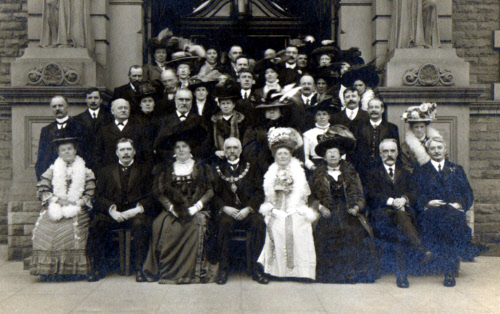
Above: Thomas Wilby Bentley in his Mayoral chains & his spinster sister, Emily in white.
By 1910, Thomas Wilby Bentley was the joint proprietor of Hope Mills, Ossett Spa ( see https://ossettheritage.co.uk/local-history/locations/spa/) with his younger brother Joseph William Bentley. Thomas was also Chairman of Governors at Ossett Grammar School(OGS) 1905 -1925. Former OGS pupils may recall the school houses called Bentley, Pickard, Marsden and Haigh after Ossett’s great and good. In 1911 only Thomas Wilby Bentley and his spinster sister, Emily, were living in the six roomed, Elder House.
Thomas Wilby Bentley, of Elder House was born on 12th May 1855 and died on 17th November 1926, aged 71 years. Probate was granted to his sister Emily Bentley; his brother Joseph William, merchant; Joseph Archer, secretary, and Thomas William Wilson, town clerk. His effects were £11,919 15s 2d. His spinster sister, Emily, born late 1862, continued to live at Elder House until her death, aged 77 years, on 26 June 1939. Probate for Emily was granted to William Louis Rene Wood, surgeon of Sowood House, The Green and Harry Garfield Chapman, headmaster of Ossett Grammar School. Her effects were £16,287 17s 8d. Thomas William Bentley was buried on 20th November 1926 at the nearby Baptist Lane Burial Ground. His sister, Emily Bentley, was buried in the same Burial Ground on 29th June 1939.
At her death in 1939 Emily Bentley left funds to enable the provision of accommodation for people less fortunate than herself. In October 1953 Ossett Borough Council acquired land at Teall Street to site Emily Bentley Homes. In 2016, Emily Bentley Homes or Almshouses are located adjacent to The Little Bull Public House and only 200 metres or so from Elder House . The Almshouses, operated by Anchor Housing Association provide unsupported amenity housing in four apartments for prospective residents who have preferably lived in the borough of Ossett for two years. A fitting tribute to the memory of a family who themselves had suffered hardship.

Emily Bentley Almshouses, 103 Teall Street, on the right. (Photograph Alan Howe 2016)
The next owner of Elder House, Dr Wynard Lionel Rose MSC, FRCPATH was a Pathologist of some repute. Born in Rotherham in 1913,he married in late 1940 had three sons, including twins.
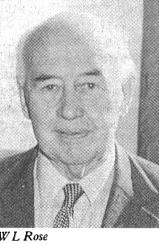
During World War II Dr Rose served in the Royal Army Medical Corps in Sudan and Italy, 1941-1946 becoming major. He was also a keen cricketer in his youth and a member of Yorkshire Cricket Club for most of his life.
In 1948 he was appointed consultant pathologist to the Wakefield Group of Hospitals: a position he retained until 1981. In 1951, he was recorded with a Teall Street address, namely “Sherwood Mount.” It is unclear if this was another house name for Elder House. Bearing in mind the setting of the house, the name Sherwood was appropriate. Dr Rose was at the “Sherwood Mount”, Teall Street until at least 1964 and between 1968 and 1983 his address was Elder House.
In October 1980 an application was made for planning consent for residential development of the 1.47 hectare Elder House site. Approved in July 1981, in February 1986 consent was also granted for the felling of 26 trees. In April 1988 consent was granted for 16 detached dwellings on the Elder House Estate and thereafter applications were made for the erection of individual properties with the last one recorded in October 1996.
Dr Rose died on 15th May 1989, aged 76 years. It is not certain how long before his death he continued to live at Elder House and the house was demolished in thelate 1980s/early 1990s. In the mid/late 1980s Elder House gained a reputation amongst the local youngsters and their imagination got the better of them as they played in and around the site. The extensive, unfenced, seemingly empty, remote and heavily wooded location was a popular haunt, as fiction got the better of fact. As is often the case there was truth in some of these rumours. After all, Dr Rose was a Pathologist.
Based on research by Alan Howe. February 2016.
Lindale Farm is situated on the Wakefield and Batley Road at Kirkhamgate just to the west of the junction with Park Mill Lane which leads to nearby Ossett. The Farm stands just beyond the Ossett boundary which is situated only several hundred metres to the south of the farm.

One of the Farm’s nearest neighbours is Park Mill Farm which is situated in Ossett, itself only a short distance from the better known Low Laithes Farm, now Low Laithes Golf Club. These three farms, and several others in Alverthorpe and Ossett cum Gawthorpe, have many things in common including their history as one of the Wakefield New Park farms. Established many centuries ago the farms were owned, courtesy of the King, at one time by the Lord of the Manor of Wakefield and subsequently the Saviles and, by marriage, the Brudenells who for several centuries carried the name, the Lord Cardigan.
The New Park comprised some 1300 acres and its several farm holdings will have been worked since time immemorial by Wakefield men and women who paid their rents to their wealthy landlords. These men and women were tenant farmers until the early 21st century when some were able to purchase their holdings as the Cardigans sold off their farm holdings known as Pease House, Kirkham Gate, Low Laithes, New Park, Low New Park, Park Mill, Low Hod, Owlers, Lodge Hill, Tuft’s, Upper Park and, the subject of this history, Lindale Farm.
In its origins, Lindale Farm shares its beginnings and early history with all of these farm holdings. The reason for their being is largely a product of topography and their ownership, at least until the 21st century, is largely a product of patronage. This history explores those early beginnings.
The farms also have in common the fact that for centuries they were worked by “working class” men and women whose families had often been tenants of the same farm holdings for many decades. This history also seeks to identify those men and women, some of whom were able to purchase those holdings, who have contributed much to the history of the New Park farms, including Lindale Farm.
An early 18th Century an estate map, dated 1711, showed the New Park “belonging to the Right Honourable George, Earl of Cardigan.” The western section of the map is reproduced below.
The history of the New Park is the history of Lindle Hill and the land thereabouts including that which is now home to Lindale Farm. Because the land was a part of the Wakefield New Park the ownership and stewardship of the land can thus be traced back 1000 years .
 1711 Estate Map of New Park (East) showing tenants and their land holdings.
1711 Estate Map of New Park (East) showing tenants and their land holdings.
The Map reveals that in 1711 the tenant of the land in the area of, what is now, Lindale Farm, was Joseph Armitage. Evidence reveals the existence of a dwelling, perhaps much older than 1711, in the location which, 300 years later, is known as Lindale Farm.
It is probable that the Child family took over the dwelling on the death of the 1711 tenant, Joseph Armitage.
It was about this time that the Cardigans contemplated the disposal of some of their land holding interests in the New Park and an Auction was held at the “Albert Hall”, Cookridge Street Leeds on 23rd July 1889. None of the New Park farms were sold. The particulars for Lindale Farm were as follows;
Importantly the sales particulars include reference to ….a modern Farmhouse…. suggesting that the house which stands there in 2021 had not long been built by 1889.
Hannah Maria Illingworth (nee Child) was the tenant farmer at that time and she died in 1892 aged 72. Her death brought to an end the 180 year occupation (1711-1892) of Lindale farm by the Child family. In 1901 Joseph Swainson, a farmer, was living at Lindale Lane Farm as tenant to the owner, the Trustees of the Cardigan Estate. By 1911 Swainson was still working the land but the six roomed house and out buildings were occupied by Richard Fairfax Fearnley.
In July 1924 George Lionel Thomas Brudenell (i.e. the Cardigan family) conveyed 42 acres and 30 perches of land, farmhouse and outbuildings to Joseph Swainson thus bringing to an end almost 300 years of Cardigan estate ownership. At least one other Cardigan New Park Farm, Owlers, was sold about the same time as Lindale Farm.
Joseph Swainson of Red Lodge Farm Kirkhamgate died in January 1936 and probate of his estate, was granted to Percy and Herbert Swainson. Joseph had an address at Red Lodge at the time of his death.
On the 6th September 1962 Herbert Swainson of Lindale Farm sold his ownership to Norman Hall, butcher of 10 Fairfield Avenue, West Ardsley, John Hall, farmer, and Edith Hall under the style of John Hall & Company. The conveyance related to all those pieces of land with dwelling house and outbuildings known as Lindale farm totalling 30.19 acres.
In August 2021 Lindale Farm remains in the ownership and occupation of the Hall family.
Green Lea House, Healey Road; A History 1889 – 2021
This grand house built in 1889 by wool and oil extractor George Jessop sits in an idyllic location on the west side of Healey Road with views across the Calder Valley. To the east was meadow land once part of the Hunting Park of the Lord of the Manor of Sowood. Much has changed.
Green Lea was to become a house whose walls had ears and tales to tell. Its history began in 1889 when George Jessop bought the copyhold land from Charles Wheatley, land and colliery owner of Sands House, Hopton, near Mirfield. This is the history of Green Lea House.
Above: Green Lea House looking south west towards Healey Bottom
George Jessop (1839 – 1891) was born at Netherton the son of a labourer. The Jessops moved to Horbury in 1861, on to Batley by 1871 and Chickenley Heath by 1881 all the time working the mills and learning the trade which was to stand them in good stead. By 1891 the family had moved to Ossett and were living in their newly completed home which they named Green Lea. Sadly George died in May 1891 having become a partner in Messrs. Fawcett, Firth and Jessop, wool extractors, based at Calder Vale Mills (previously Gartside’s Dye Works) at Healey Bottom.
Following George Jessop’s death his widow, Martha (nee Fawcett), continued to live at Green Lea House with her two sons, Batley born Arthur Jessop(1869 – 1931) and Sydney, and her daughter, Margaret Edith (Maggie)born in Ossett.
By 1901 Arthur, aged 32, a wool extractor and employer was married with a son, George Edward born in Ossett in 1893. He was to be the only child of Arthur and Ann Eliza (nee Clay) who married in late 1891.
The widowed Martha died in 1903 and in 1911 Arthur, Ann Eliza and George Edward, aged 17 years, were living at Green Lea. Father and son were working in the business.
Left: Arthur Jessop with his wife Ann Eliza Clay. Photograph courtesy of Andrew Clay
Then, on 4th August 1914, Great Britain declared war on the German Empire. George Edward left his Green Lea home, earned a commission in July 1915 and as Lieutenant George Edward Jessop, aged 23, he embarked for France on 21st August 1916.
Granted leave in March 1918 George Edward Jessop, by then of Green Mount, was married on the 15th March 1918 at the Wesleyan Chapel, Wesley Street, to Gladys Mary Mitchell, the daughter of George William Mitchell of Wellfield House, Dale Street. Less than four weeks later, on 10th April 1918 George Edward was killed in action in France. Gladys Mary Jessop (nee Mitchell) was still grieving the loss of her husband of only four weeks, when she reached out to help other soldiers, unfortunate in their circumstances, but more fortunate than the man she loved. On 1st October 1918 she was engaged as a Nursing Sister at St. John’s Auxiliary Hospital, Wentworth House, Wakefield.
By the time of Lieutenant George Edward’s leave to marry in March 1918, Arthur Jessop and his wife Ann Eliza had sold Green Lea House and moved to the nearby Green Mount on Ossett Green. The new owners and occupiers of Green Lea House were Robert Dixon Smith and his wife Sarah (nee Hiley). Robert Dixon Smith, a mungo manufacturer died and was buried at Holy Trinity Church in April 1933.
In 1938, the house was sold for £1,250 to Louisa Dunning (nee Sykes), the wife of William Strickland Dunning who married in Wakefield in summer 1915.William was born in Stockton on Tees in 1889 and by the age of eleven in 1901 he was being educated at the Ackworth (Boarding) School for the Society of Friends (Quakers). Louisa Sykes aged nine years was attending the same Quaker School. Perhaps the couple were childhood sweethearts. By 1911 William was living with his parents, an elder sister and two younger brothers at the ten roomed house at Belmont Grove, Leeds. William was working with his father as an agent and sugar broker. Meanwhile in1911 Louisa was living with her widowed mother , Louisa Abstemia Sykes at the eight roomed Fairfield House, Horbury. Following his marriage to Louisa in summer 1915 they moved south and the couple had two children, Barbara S. and Pete S., born in 1921 and 1923 in St. Albans.
By 1939 the couple had moved back north and acquired Green Lea. At that time William was working as a managing director sugar merchant and sports goods manufacturer. At first sight this may appear an ecletic mix of employments except that William’s wife, Louisa, was the daughter of William and Louisa Abstemia Sykes (nee Crabtree) who had established William Sykes Ltd. of Horbury, sporting goods manufacturers.
Louisa and William Strickland Dunning owned “Green Lea” for only four years and in 1942, the house was sold to Louisa’s family business, William Sykes Ltd. Later, Sykes merged with other sporting goods manufacturers to become Slazengers. A generation of cricketing superstars including Viv Richards, Geoffrey Boycott and Don Bradman have thrilled crowds and graced the game using iconic Slazenger equipment.
It is not known whether William Sykes Ltd. used the house as offices or for accommodation. By this time Louisa and William Strickland Dunning had moved to live at Jenkin Lane, Horbury and sadly in late 1945 or early 1946 Louisa Dunning died aged 54. In Autumn 1946 William Strickland Dunning, a widower, married Amy M. Moore in London and by the 1950’s the couple were living in Harrogate. William died there in early 1971, aged 81 years.
Meanwhile in September 1948, “Green Lea” was sold to Jonas Woodhead (Ossett) Limited, manufacturers of springs and shock absorbers for motor vehicles. The Company still exists but has long been dormant; its parent company is Carclo plc of Springstone House, 27 Dewsbury Road, Ossett. Whether it was intended to use the house for office accommodation is not clear.
In any event in May 1949 Woodheads appear to have sold Green Lea House to Mrs Isabel Dodds who lived at Green Lea House until at least 1961. By 1939, claiming to be single and born on the 25th December 1910, Isabel Dodds was living at 1, Limes Avenue, Staincross near Barnsley and working as a dietitian for the West Riding County Council. Her neighbours at 3, Limes Avenue were , Alice Dyson (nee Thackray) and her husband Arthur Dyson, a colliery surveyor and Air Raid Precautions warden. By 1956 the neighbours Isabel Dodds and Arthur and Alice Dyson were living at Green Lea.
In 1956 the Bradford Observer of 10th August 1956 reported that Ossett born mining surveyor and noted bass singer, Mr Arthur Dyson of Green Lea Healey Road, was moving to Worcestershire to take up a new position the following month. Arthur Dyson was born in Ossett in 1906 the younger son of colliery deputy William Dyson and Miranda (nee Wood) who, in 1911, were living with their two sons at Park Square, Ossett. Arthur returned to Yorkshire sometime after his employment in Worcestershire. He lived at Newmillerdam and died on 3rd November 1988, aged 82.
In 1958 things were to change again at Green Lea when the following Notice placed Albert Silverwood Barnes there in May of that year; he was still there in 1961 when Isabel Dodds was also in residence.
In October 1916 Albert was living at Wombwell Main, near Barnsley. He was eighteen years of age and a clerk. It was the same month that he was called up to serve with the Royal Horse Artillery and Royal Field Artillery in the Great War. Albert, service number 185827, was made Lance Bombadier in June 1917 and embarked for France on 14th November 1917. He was promoted to Corporal in October 1918 a month before the Armistice. He embarked for home on 3rd January 1919 and was demobilised on the 19th January 1919. Albert was subsequently awarded the British and Victory Medals for his service overseas in a theatre of war and then set about his life and work on civvie street finding his way in the 1950’s to Green Lea.
In 1939 Albert, born 25th December 1897, was living with his wife, Marjorie Evelyn (nee Watson) and child, Howard, at Wombwell where he was working as a Colliery Chief Cashier. Albert Silverwood Barnes died at York in Autumn 1974 aged 77 years. His wife, Marjorie Evelyn, born 1907, died in summer 1983 aged 76.
On 22nd October 2001 Gregory Joseph May and Susan Valerie May( nee Pemberton ) bought Green Lea and they retain the ownership of this grand house at the time of writing this history (August 2021).
For now this is the end of this history of Green Lea, Healey Road, Ossett. It is indeed a house which has walls that have tales to tell. Its maker, George Jessop died in 1891 only shortly after the house was built. It saw more misfortune in 1918 when George’s grandson, Edward George Jessop was killed in action in France. But there some good times too when William Strickland Dunning and Louisa Sykes, both educated at Ackworth Quaker School, became childhood sweethearts, wed and lived at Green Lea in the late 1930’s & early 1940’s. It was also home to a World War veteran, Albert Silverwood Dyson.
The House also has an odd story to tell. Isobel Dodds, a dietitian, and husband and wife, Arthur and Alice Dyson were next door neighbours at Lime Avenue Staincross in 1939. It seems shortly afterwards that they upped and came to Ossett to live at Green Lea in the 1940’s until the 1960’s. I believe there’s also more than meets the eye about dietician Isobel Dodds too, but that’s for another day.
I am grateful to Greg & Sue May for granting access to their home and for the opportunity to examine some of the Copyhold Deeds and subsequent conveyances.
Green Mount, situated at the junction of Southdale Road and Ossett Green, is an elegant residence, erected on the site of the cottage tenanted by successive generations of Pickards. Part of the history of the house is also the history of this branch of the Pickard family who lived at Green Mount, albeit for only a relatively short period of time, between 1876 and 1891. Before that though “the Pickard family …. lived there for nearly a century past.” This land, part of which was to become Green Mount, a grand Victorian house was purchased by Andrew Pickard in May 1876. By 1891 the Pickard siblings David, Andrew and Hannah who lived there succumbed to various illnesses which were to prove fatal.
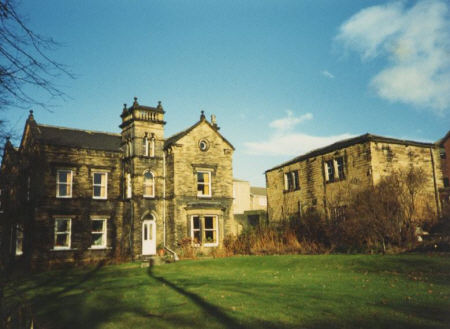 Green Mount purchased in 1876 by Ossett mill owner Andrew Pickard
Green Mount purchased in 1876 by Ossett mill owner Andrew Pickard
The Pickards 1876-1891
The Pickard family had existed in Ossett for generations and the family lived in a rented cottage, said to be where the substantial dwelling “Green Mount” would later be built and which was purchased by Andrew Pickard in 1876. The name Pickard is said to have its roots in the men of Picardy, France who fought with The Duke of Normandy, William The Conqueror, in the Conquest of England in late 1066.
Ossett grocer and draper, George Pickard (born 9th April 1798, a Quaker by birth) married Hannah Mitchell (born 1805) in 1824 and they had four children, two sons and two daughters: Sarah, born in 1826; David (1830), Andrew (1835) and Hannah(1838).
George Pickard’s two sons, David and Andrew, were successful clothiers. By 1871, David, a bachelor, was in partnership with Mark Wilby of Manor Mill, Ossett. Andrew (35) also unmarried, was a “Woollen Manufacturer” with mill premises in Aire Street, Leeds.
On 8th May 1876 Andrew Pickard purchased “….all that Capital messuage or dwellinghouse called Green Mount” from the wealthy Charles, Richard and Caroline Wheatley of Hopton; Charles &
Caroline were siblings and Richard was their cousin and also husband of Caroline. Charles was a bachelor and a cousin of the immensely rich Haigh family and inter alia Charles inherited this land and property from the Haighs on the death of the last of that line in 1857. The Haighs of Longlands House, Flushdyke once owned 300 acres, 10% of Ossett’s total acreage.. https://ossettheritage.co.uk/local-history/locations/houses/
In 1881 Andrew bought a further, adjacent, four acres from the Wheatley family and the Green mount estate was complete. Green Mount “with the outbuildings, greenhouses and pleasure grounds thereto belonging”, reflected the wealth that the Pickard brothers had achieved in business. However the family was not known for its longevity and In the following nine years, 1882-1891, the brothers, David and Andrew and their sister, Hannah, were to die of disease in their fifties.
George Pickard, the father, died after a long illness on March 7th 1852, aged 53 years. His daughter, Sarah, aged 35 years, died on May 14th 1857 of a diseased knee joint and her mother, Hannah (senior) died on April 25th 1862 aged 59 years. David, aged 52 years, died on July 6th 1882 of a fatty degeneration of the heart and his brother Andrew died on September 18th 1890 aged 54 years with heart problems and pneumonia.
None of Hannah’s closest family members reached 60 years and she too died, on June 29th 1891, aged 52 years of a malignant disease of the pelvis. All the family were members of the adjacent Congregational Church and were buried in the Church Burial Ground at nearby Dimple Well.
By 1881, bachelor David and spinster Hannah Pickard of Green Mount were living with Leeds born ‘George Pickard’ aged 10 and described as David’s son. David Pickard died intestate in July 1882 and left an estate worth £48,072 11s 7d. Andrew died in September 1890, aged 54, and left the majority of his estate to his only surviving sibling, spinster Hannah Pickard. He also left part of his estate in trust to young George Pickard the adopted son of my late brother David Pickard”. Andrew’s sister Hannah, the only surviving sibling, acted as the trustee. Andrew left £164,093.
Hannah Pickard died on the 29th June 1891, leaving £140,000 and with no heirs, the family fortune was inherited by David Pickard’s adopted son George who was now 21. Hannah left Green Mount and “four acres of land bought from Messrs. Wheatley” to young George Pickard, “the Pickard family having lived there for nearly a century past.” As is well known Hannah also left a long list of legacies to various people and organisations.
Young George Pickard, who as an adopted son of the late David Pickard inherited a significant fortune including Green Mount, which Hannah Pickard had left to him, presumably to keep the house in the Pickard family a little longer. George, aged 21, died a year after Hannah in spring 1892.
Young George’s heir was Frederick Robert Hird, a surgeon of Scarborough and cousin of the Pickard siblings. In December 1892 Frederick sold the part freehold and part copyhold Green Mount and almost four acres to neighbour Dr. John William Greenwood, surgeon of Sowood House Ossett. John William Greenwood paid £850 for the part copyhold interest in Green Mount and £2,000 for the freehold and the adjacent freehold land.
The 20th Century 1900-2000.
In 1901 Green Mount was rented by Samuel Ellis, a woollen manufacturer with premises in Savile Town. In October 1901 his only daughter, Olive was married. Her brother, Robert Hill Ellis (subsequently a Major with KOYLI) was unable to attend being in South Africa. The bridal party adjourned to Green Mount where breakfast was served in a marquee which had been erected on the lawn.
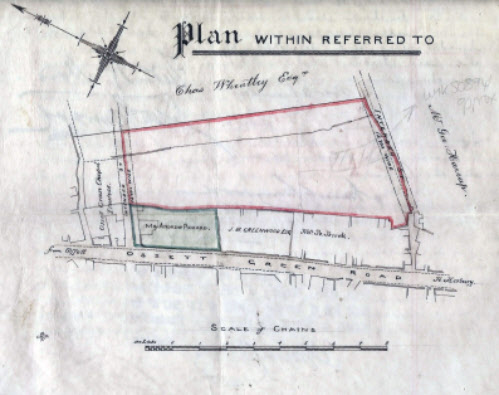 Plan from Conveyance 21 December 1892 showing Green Mount (green) & adjacent land (red) sold by F.R. Hird to John William Greenwood. Note the words “Intended Street 12 yards wide” which was to become Southdale Road.
Plan from Conveyance 21 December 1892 showing Green Mount (green) & adjacent land (red) sold by F.R. Hird to John William Greenwood. Note the words “Intended Street 12 yards wide” which was to become Southdale Road.
John William Greenwood died in July 1904 and ownership of Green Mount passed to his eldest surviving son, William Greenwood, who was also a surgeon. By 1910, George Henry
Briggs and his family were the tenants of the ten roomed house which was still owned by Dr. William Greenwood. The Briggs family kept a little ‘zoo’ in what was the garage of Green Mount where they had birds, a donkey and various other pets. George Henry Briggs died in 1915 and the family left the house soon afterwards.
Dr. William Greenwood died intestate in January 1911, aged 48 years and letters of administration were granted to his wife, Alice (nee Alford) who was also William Greenwood’s cousin. Alice died in 1952, before completing the administration but it appears that Green Mount remained in the ownership of the Greenwood family for a little longer.
Between 1915 and 1918 Green Mount became home to wool extractor Arthur Jessop, his wife Ann Eliza (nee Clay) and their only son, George Edward. The Jessop family previously lived at the equally grand Victorian house, Green Lea, which they built in 1889 on Healey Lane. War with Germany was declared on 4th August 1914 and Lieutenant George Edward, aged 23, embarked for France on 21st August 1916. Granted leave in March 1918 George Edward Jessop, by then of Green Mount, married Gladys Mary Mitchell on 15th March 1918. Less than four weeks later, on 10th April 1918 George Edward was killed in action in France. Arthur Jessop J.P., died at Green Mount on 27th April 1931 and is buried at St. John’s Church, South Parade, Ossett.
By 1937 Green Mount was occupied by woollen mill manager Henry Eric Firth, his wife Emma (nee Blackburn) and their two young sons. In 1939 the Firth family were still living at Green Mount which also had addresses no. 2 Green Mount and Green Mount Cottage; the former occupied by Alice Firth, aged 71 years and a domestic servant and the latter by Clarence Naylor, a railway shunter, and his wife Kathleen. Henry Eric Firth was still living at Green Mount in April 1955 when his son, Michael Eric, a pilot, married Margaret Nettleton, the daughter of Samuel Broadhead Nettleton.
Since 1939, or perhaps earlier “Green Mount” was providing homes for three families on its estate. Numbers 1 & 2 were parts of the original 1876 dwelling known as Green Mount; Green Cottage appears to have been added (or converted) with a Southdale Road frontage. In 1957 Alice Joyce Greenwood, spinster daughter of William and Alice Greenwood, brought the Greenwood family ownership to an end. Joyce (as she was known) conveyed Green Mount in October 1957 to John Dent (no.1), in November 1957 to Arthur Frederick Morton (no.2) and in October 1957 to Clarence & Kathleen Naylor (no.3, previously known as Green Mount Cottage)
By 1961 Ronald Dent was living at no. 1 Green Mount ((4 beds, 3 baths, 2 recpts), Robert W. Spurr lived at no. 2 Green Mount and Clarence Naylor lived at Green Mount Cottage as he had in 1939. In September 2021 the ownership of all three of the Green Mount dwellings is held by Andrew Paul and Kathryn Joanne Thackray. No. 1 Green Mount was acquired by the couple in August 2005, no. 2 in June 2002 and no.3 in March 2010.
A full history of Green Mount on Ossett Green can be seen here https://ossettheritage.co.uk/links/
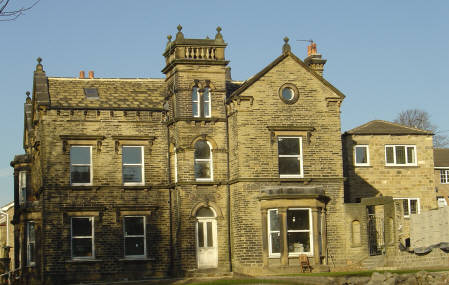 Above: Green Mount in 2007. The building shown above at the side of the house has now been demolished.
Above: Green Mount in 2007. The building shown above at the side of the house has now been demolished.
Research by Alan Howe November 2015 (updated September 2021) Notes: Thanks also to Helen Bickerdyke for her research of Green Mount.
THE HISTORY OF SPRINGSTONE HOUSE 1830- 2021 By Alan Howe
Springstone House is situated at the junction of Springstone Avenue & the Wakefield to Dewsbury Road (A 638) formerly known as the Wakefield to Halifax Turnpike Road, The Street, Upper Street, Streetside or Paleside. Springstone House was granted Grade II status by Historic England in May 1988.
In 1830 a Trade Directory records John Sanderson Archer, as a solicitor of Spring Stone House, The Street, Ossett. This dates Spring Stone House to twenty years or so earlier than hitherto thought. In 1840 john Sanderson Archer was living at Springstone House in Paleside.
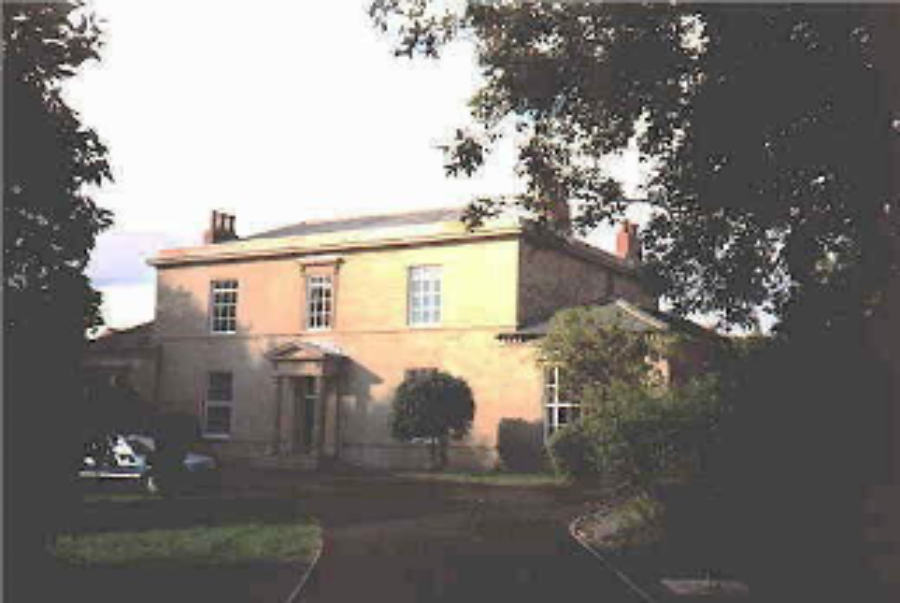
Above: Spring Stone House, The Street, Ossett built in the mid/late 1820’s.
John Sanderson Archer was born in 1795 and baptised in Ossett, the elder son of whitesmith Joseph Archer (1767- 1849). He died in 1840.
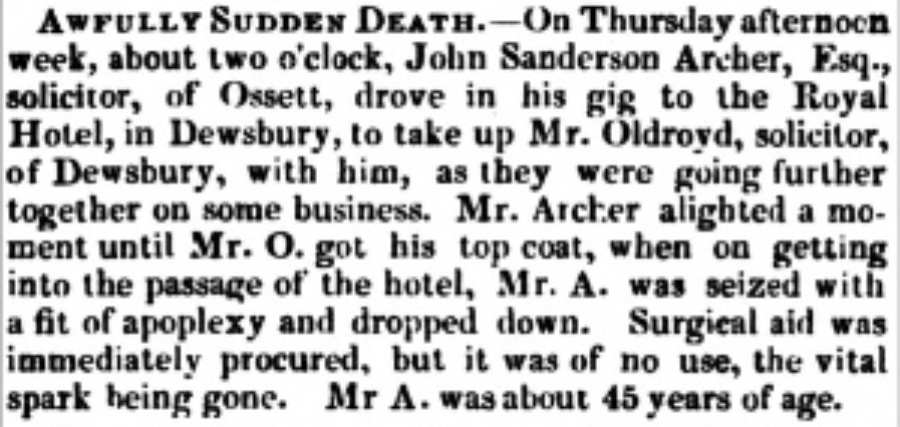
Above: Report of John Sanderson Archer’s death. York Herald 22nd August 1840
In June 1841 Springstone House was tenanted by two recently qualified solicitors, William Allott and Joseph Haxby .Two years later the 1843 Ossett Tithe Award shows Springstone House on its map and records the owner of the land upon which the House then stood as Archer’s brother in law,Thomas Halliley , and the tenant as William Allott (1812-1875).
In 1854 the first Ordnance Survey of Ossett was published . The map included Spring Stone House aside the Wakefield to Halifax Turnpike Road convenient for travellers and businessmen for the direct link to Wakefield to the east and Dewsbury to the west.
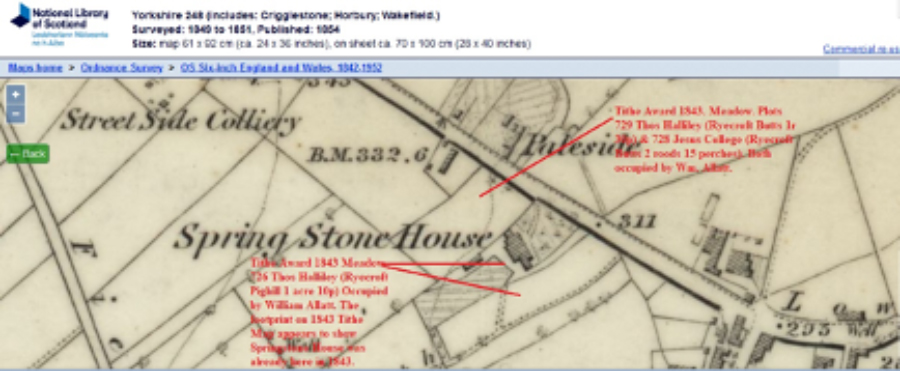
Above; Spring Stone House named on the 1849 surveyed O.S. map of Ossett published in 1854.
Springstone House’s next owner was to be Dr. William Wood Wiseman M.R.C.S., L.S.A. (1810-1885) and by 1834 he was a practicing surgeon in Ossett having married Mary Greaves of the wealthy Ossett woollen manufacturing family in 1837. By 1841 the couple and their first child, a daughter, were living in Ossett at a “Town” address. By 1851 the Wiseman family had moved to a larger dwelling at “Town Knowl” on Dale Street . On Census day 1851 Springstone House appears to have been uninhabited
By 1853 William Wood Wiseman (1810-1885) w as the “self occupier” of Springstone House, Ossett Street Side and this was to be his home and Practice Springstone House until his death there on 10th July 1885 and was buried at Holy Trinity Church, aged 75 years.
The Family Memorial remains there to this day and bears the names of their younger son, William Henry Wiseman (1847-1859) alongside his mother Mary Wiseman (1819-1881) and father William Wood Wiseman (1810-1885).
In his 1879 Will, William Wood Wiseman referred to Springstone House and other land and property purchased from John Archer. William left Springstone to his only surviving son John Greaves Wiseman (1845-1934) a Physician & Surgeon who in 1881 was living at Wesley Street but by 1891 he was living at Springstone House with his newly married wife, Bertha Maud Thomas. By 1902 John Greaves Wiseman was recorded as living at The Queen, Bath Road, Bournemouth

Above: Photographs of the Wiseman Memorial at Holy Trinity Church courtesy of Joan Smith
By 1904 John Greaves Wiseman had sold Springstone House to building contractor Francis Hey Whitlow Denholm (1857-1926) who by that time lived there. The 1988 listing of Springstone House refers to its late C19 or early C20 wings. We need look no longer for the builder of those wings and the naming of the adjacent Denholme Drive (originally Denholm Drive), built post 1905 is no longer a mystery.
In 1905 John Greaves Wiseman was 60 years of age and appears to have left Ossett forever and headed south where he spent the rest of his life. In 1911 he was living in Twickenham where he died in May 1934, aged 88 years. The total of his effects were £44815 (current values, £3.28m).
In 1910 Francis Denholm was recorded as the owner of Springstone House but he was living elsewhere and renting the dwelling to tenants. Indeed since about 1905 the House had been occupied less by its owner and much more by a rich variety of middle class tenants and this appears to have been the practice for as long as Springstone House remained as a dwelling.
By way of example in 1911 Springstone House was let to two families who between them comprised thirteen men, women and children. The tenants were Paddington born Thomas Float, a railway traffic agent, and Dundee born William Hield, a carpet yarn merchant. By 1913-14 George Herbert Wood ( Ossett Shoddy manufacturer) and William Muir Oddie ( chartered accountant and Ossett Borough Treasurer) were in occupation. Mr Oddie remained at Springstone House until 1928
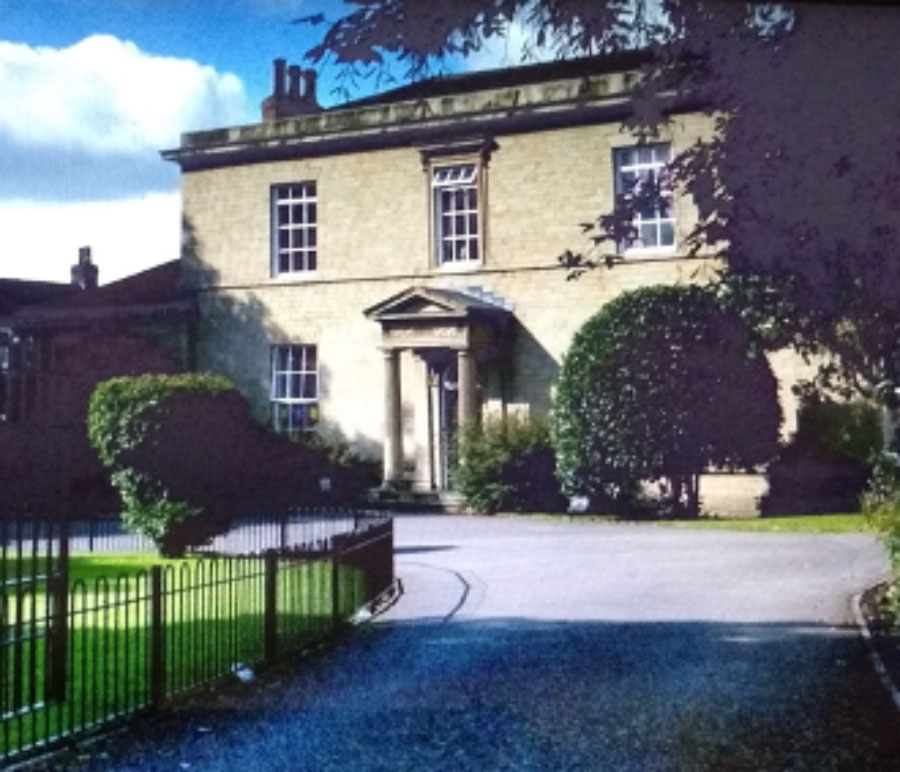
Springstone House July 2000 Copyright IoE Mr John Ulrick. Source Historic England Archive
Francis Hey Whitlow Denholm died at Halifax in January 1926 aged 68; he left nine surviving children including seven sons.
By 1939 four tenant families were occupying Springstone House; Mabel Herbert (a secondary school teacher at Ossett Grammar School between 1922 and 1948 ), Joseph Ellis (Joiner & Undertaker), Geoffrey T Auty (Weaving Shed Manager& Special Constable)) and James B. Tonkin (a Minister of Religion with the Unitarian Church who had moved from a living at The Parsonage, Lydgate, Fulstone). In this year then Springstone House was home to nine persons; three couples and the unmarried Mabel Herbert. None of the occupants had children.
By 1961 Springstone House was home to four occupants by the names of Leslie Garforth, William J Hughes, Ann Battye and Jeffrey Booth. William J. Hughes was a history teacher at Ossett Grammar School between 1947 and about 1970.
Its days of being a dwelling were about to come to an end and in January 2002 Springstone House was acquired by Bushel & Company Ltd of Scotland Farm, Dry Drayton, Cambridgeshire who remain the owners (2021). Shortly after 2002 it was occupied by Carclo plc, a technology-led plastics business with global, integrated capabilities and operations. In 2021 Springstone House continues to be the registered office of Carclo plc.
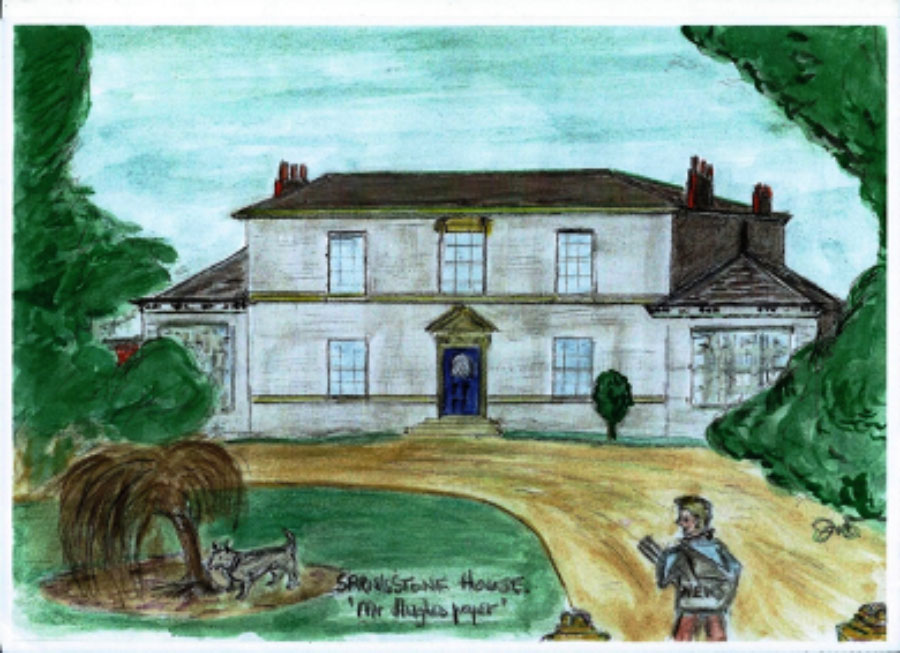
Sketch of Springstone House by Douglas Brammer entitled “Mr Hughes’ paper”
This sketch shows the grand house at the junction of the A638 and Springstone Avenue and records a young Douglas Brammer on his early morning paper round. He is about to deliver a newspaper to a resident of Springstone House, Mr Hughes, who was also a teacher of history at Ossett Grammar School. He taught Douglas and they knew each other rather well.
The full version of the History of Springstone House can be seen here
Alan Howe
August 2021